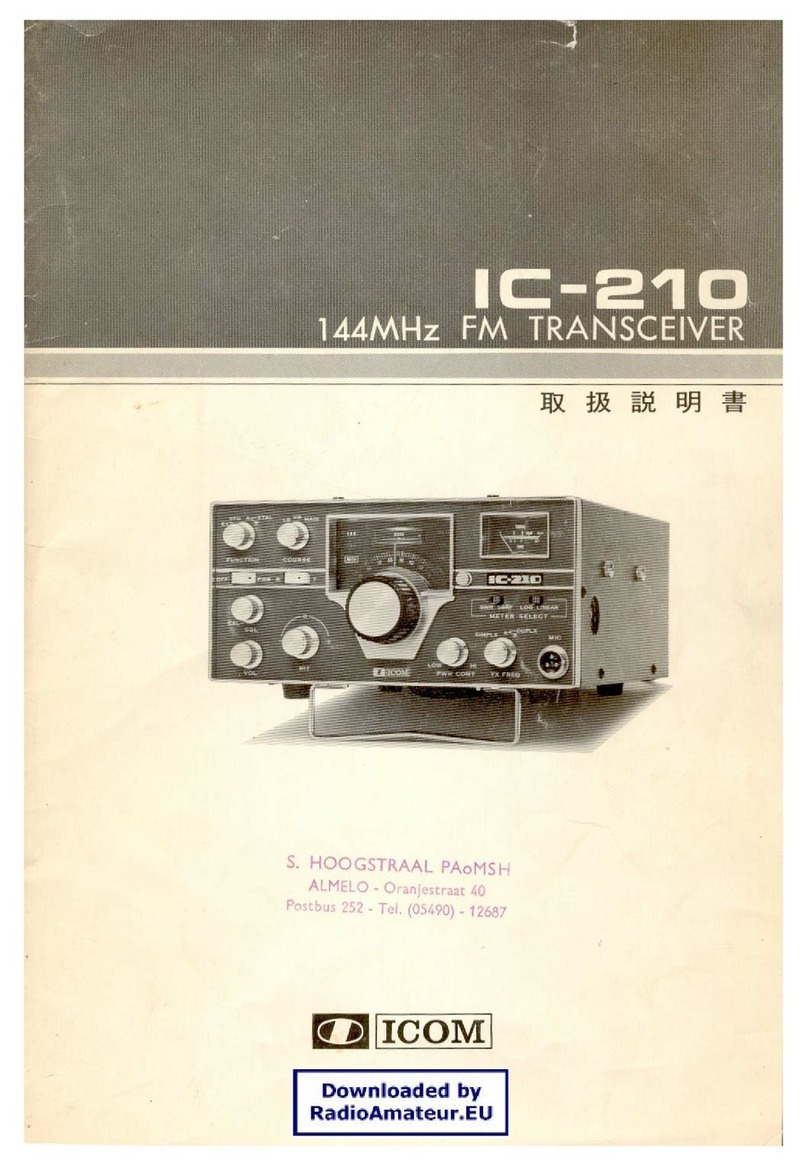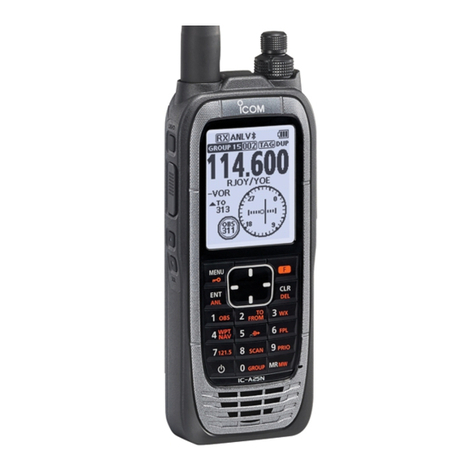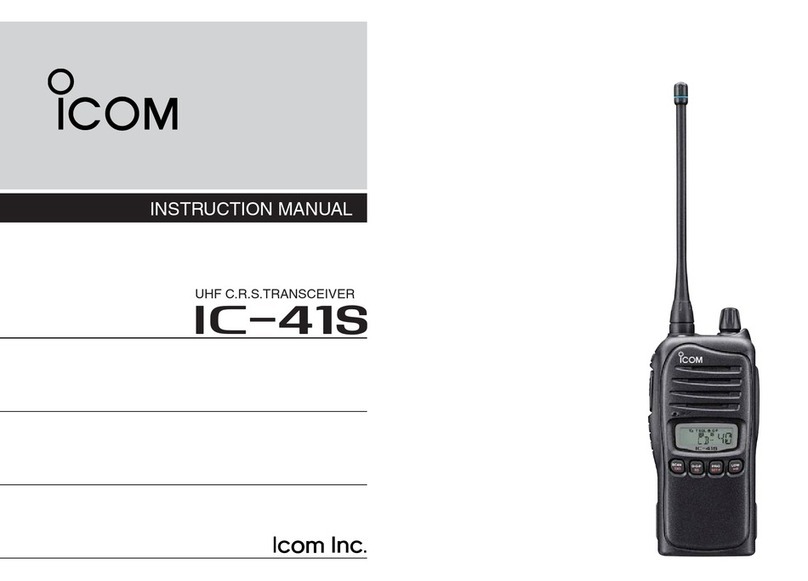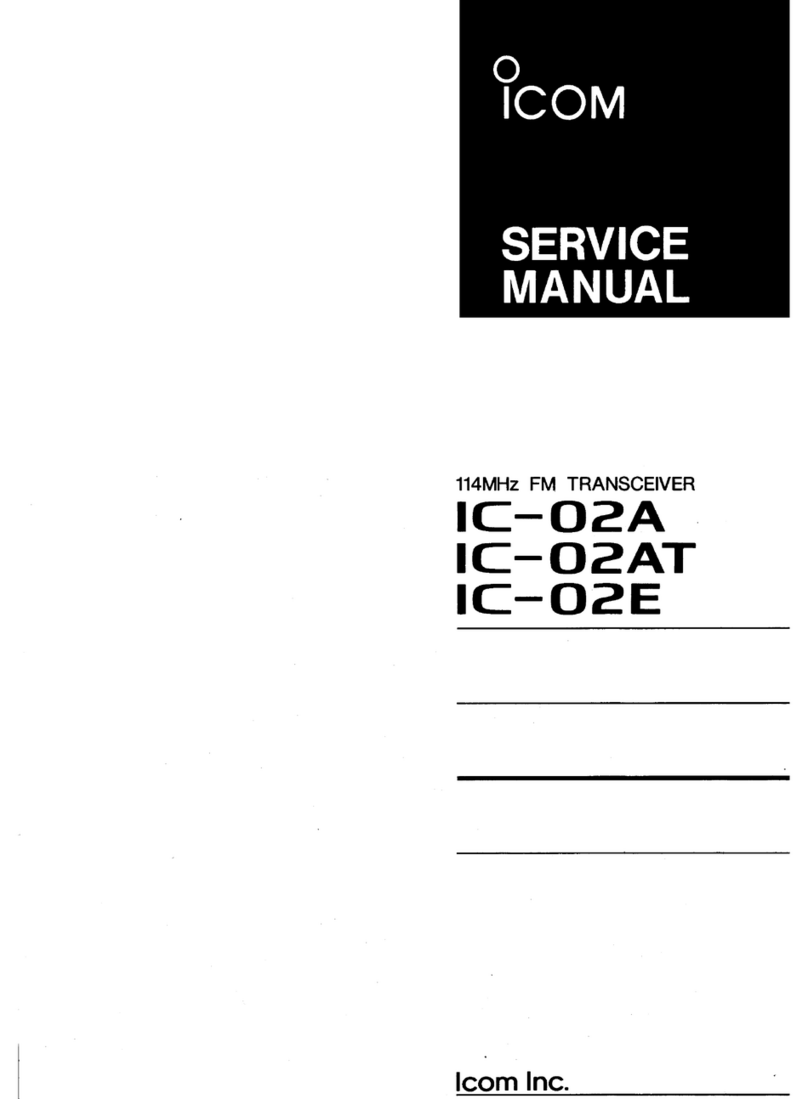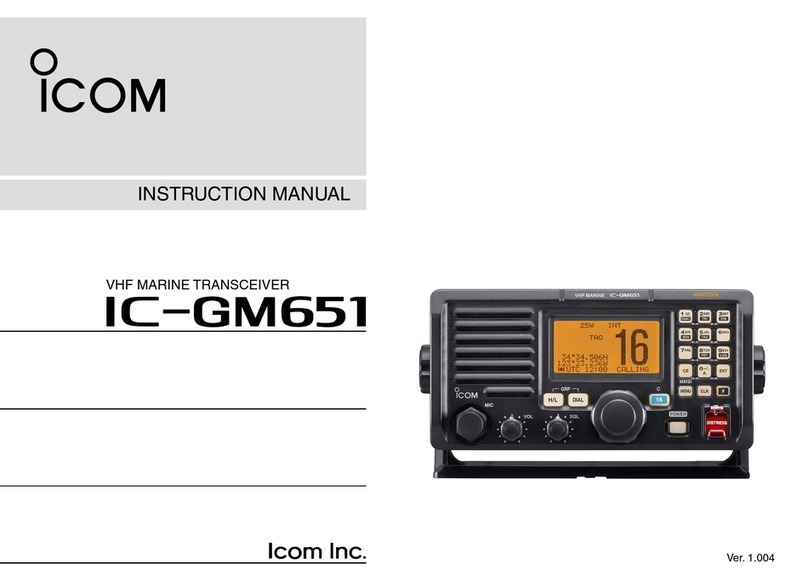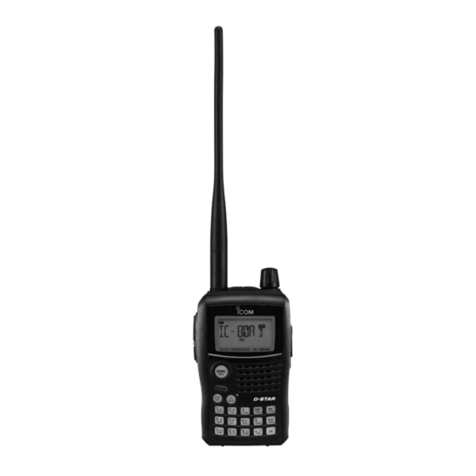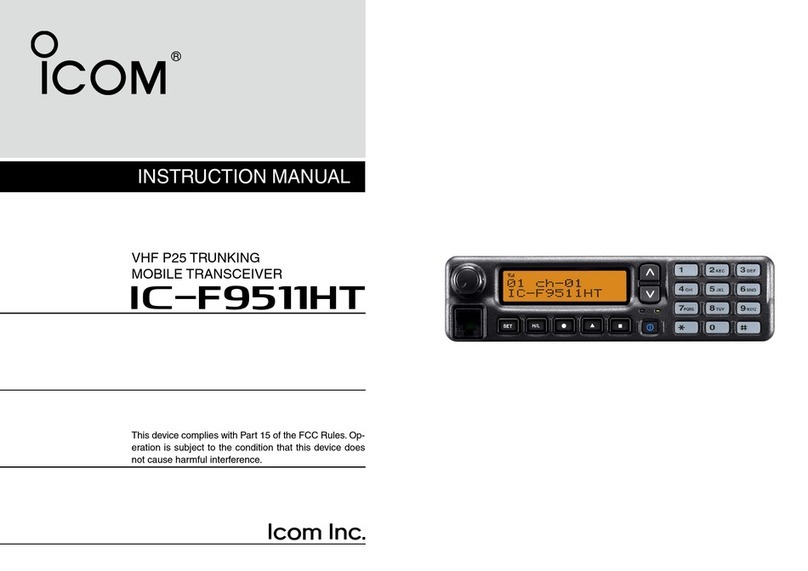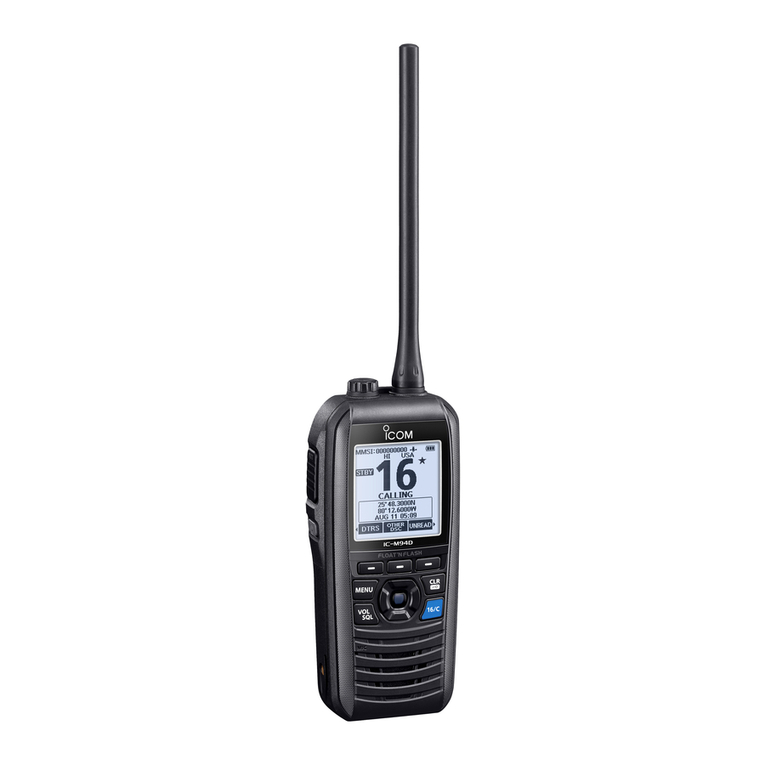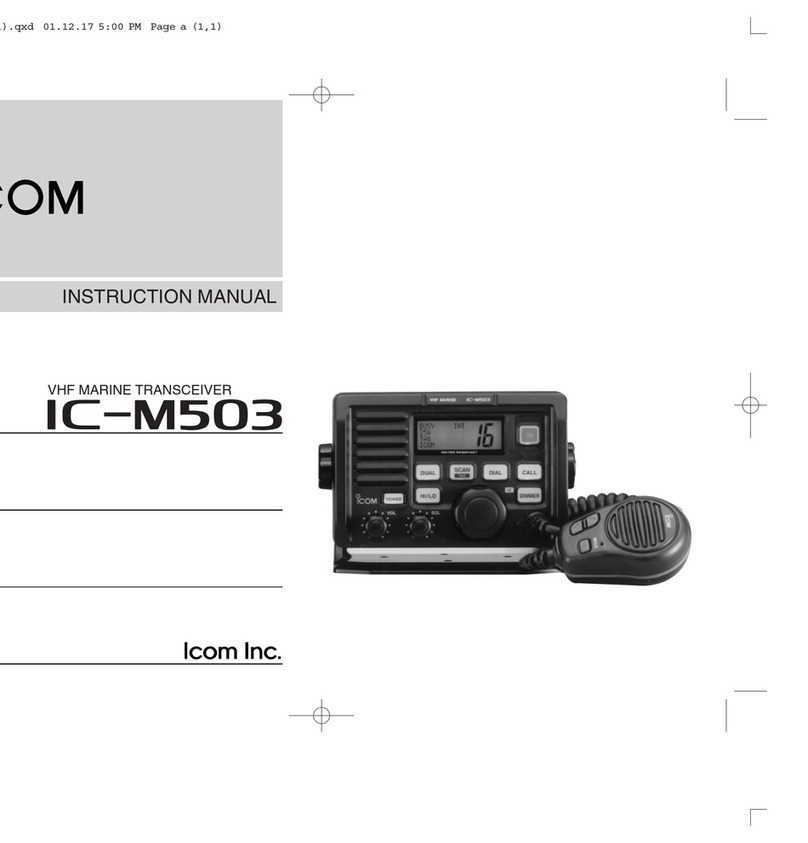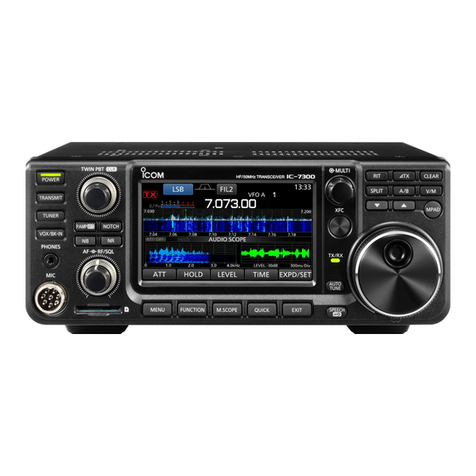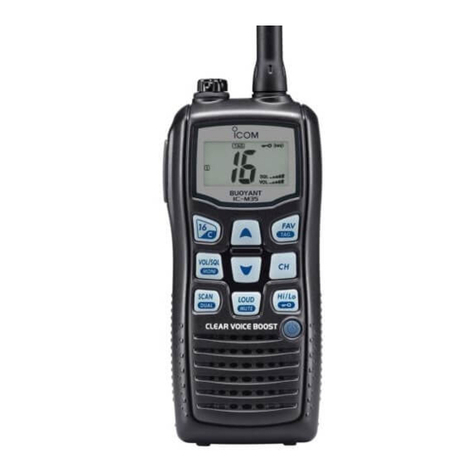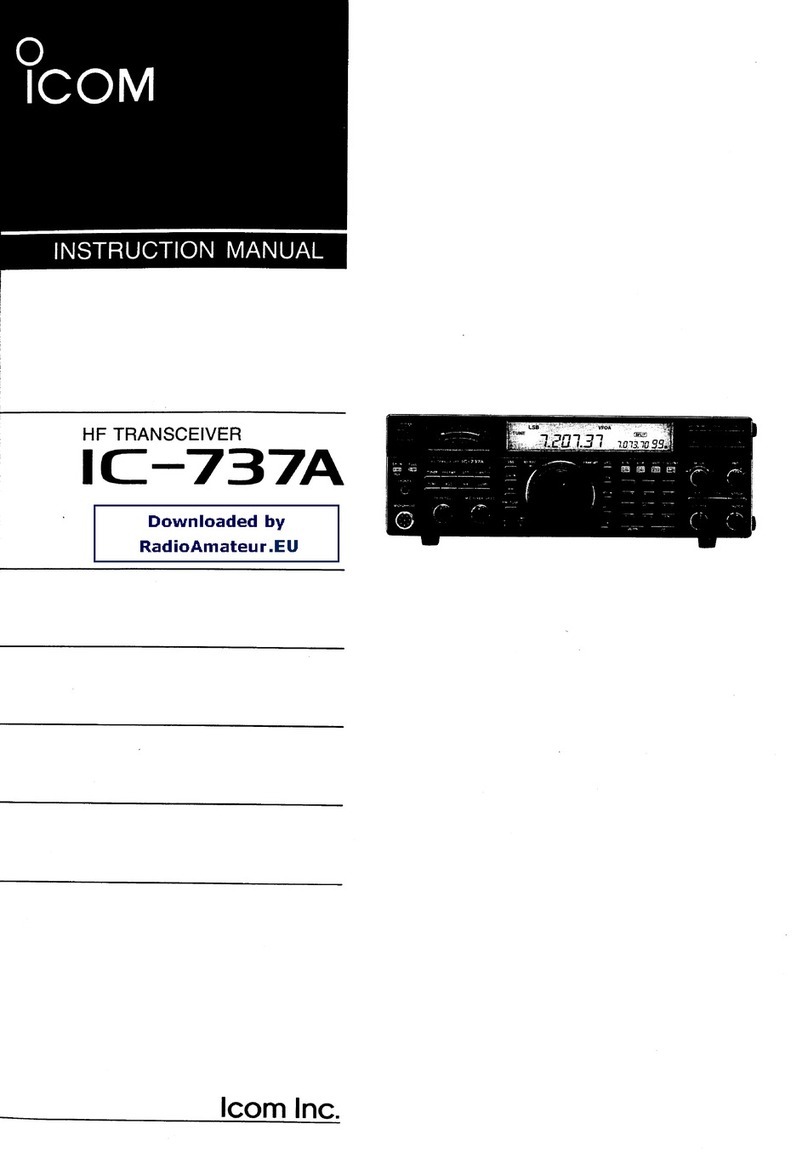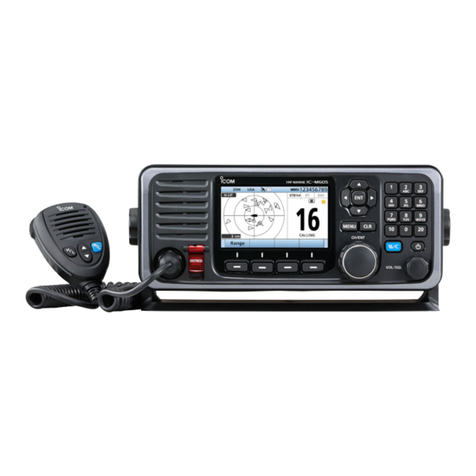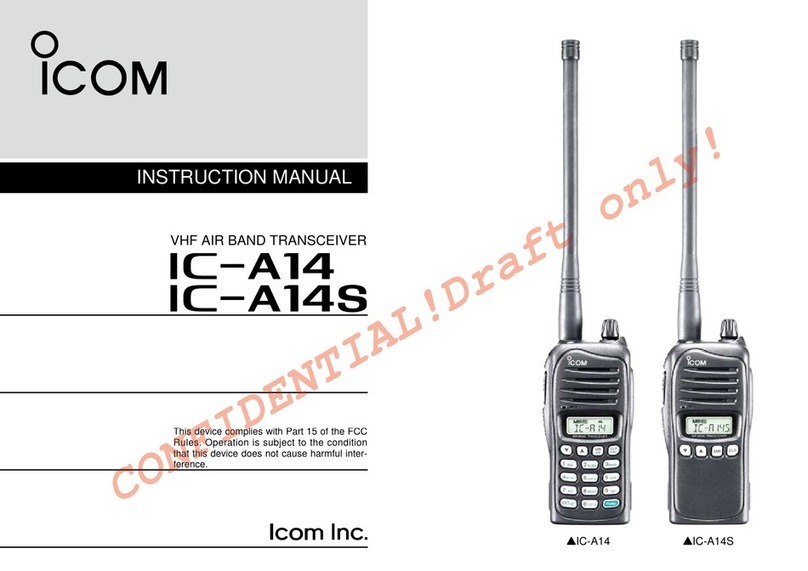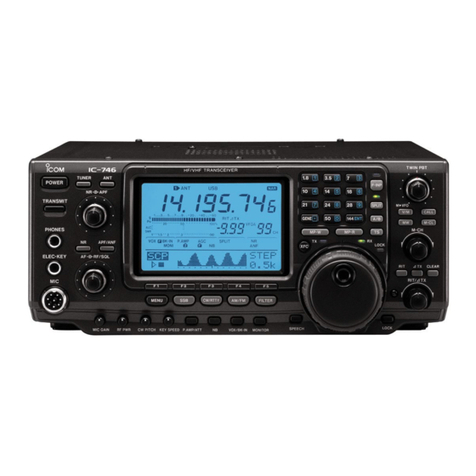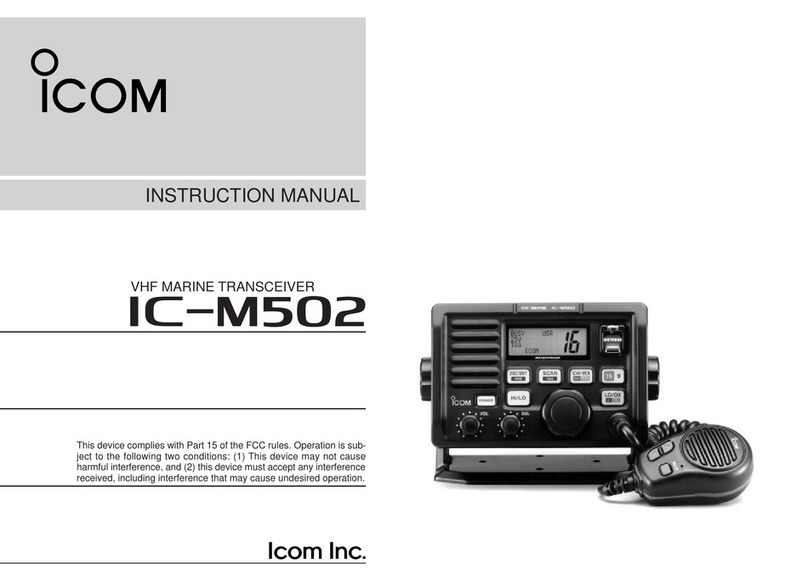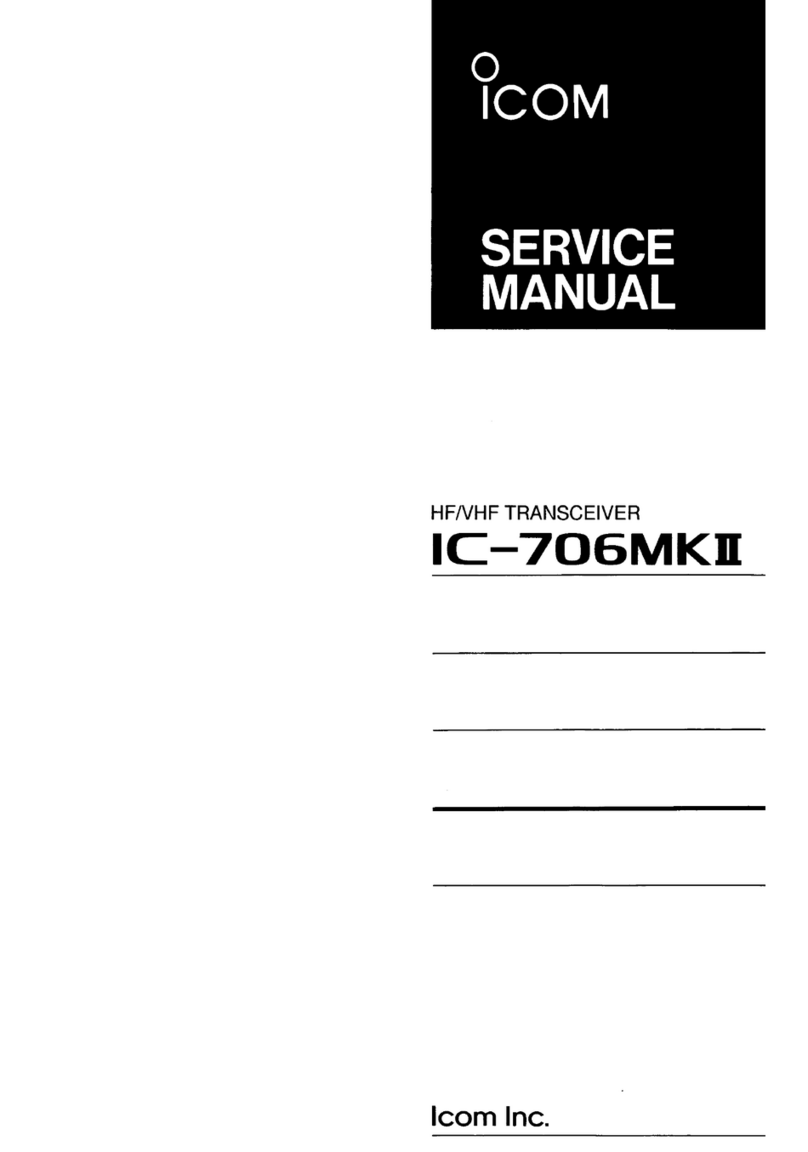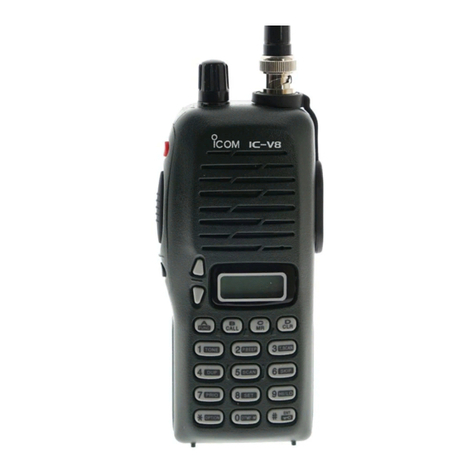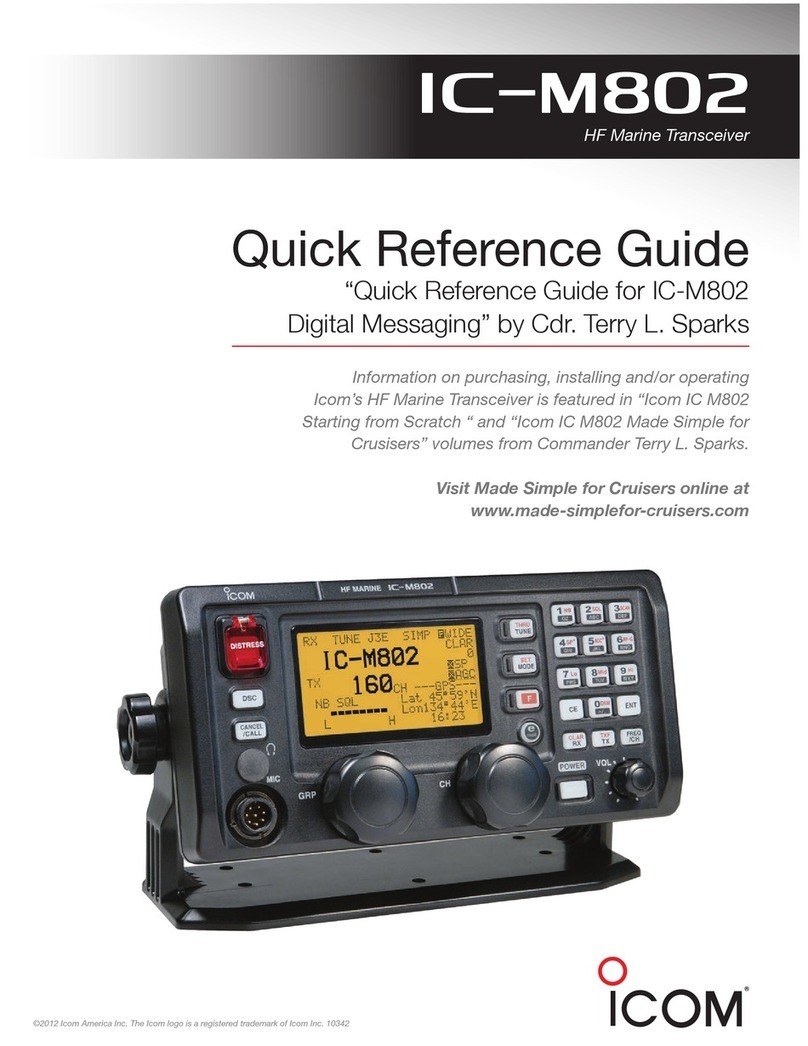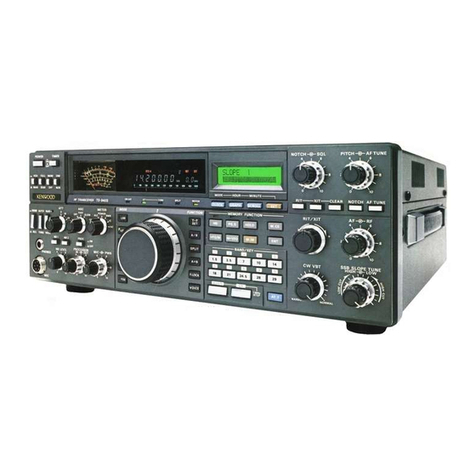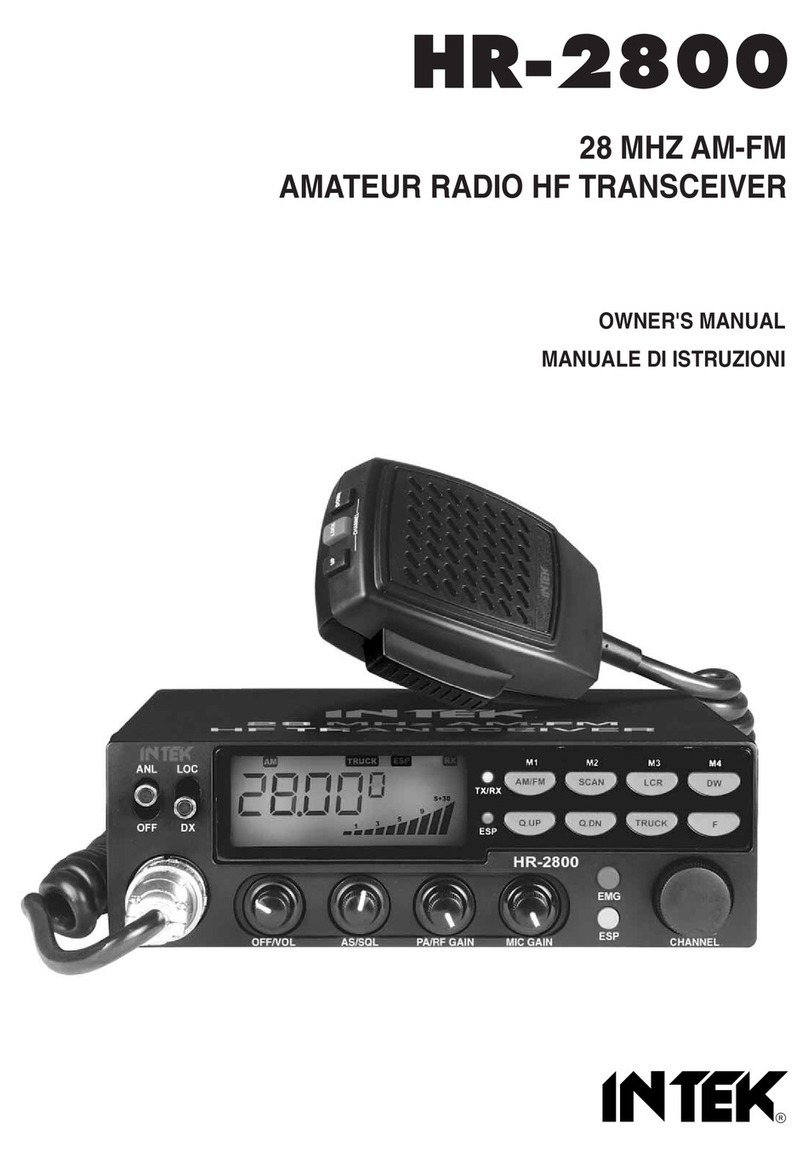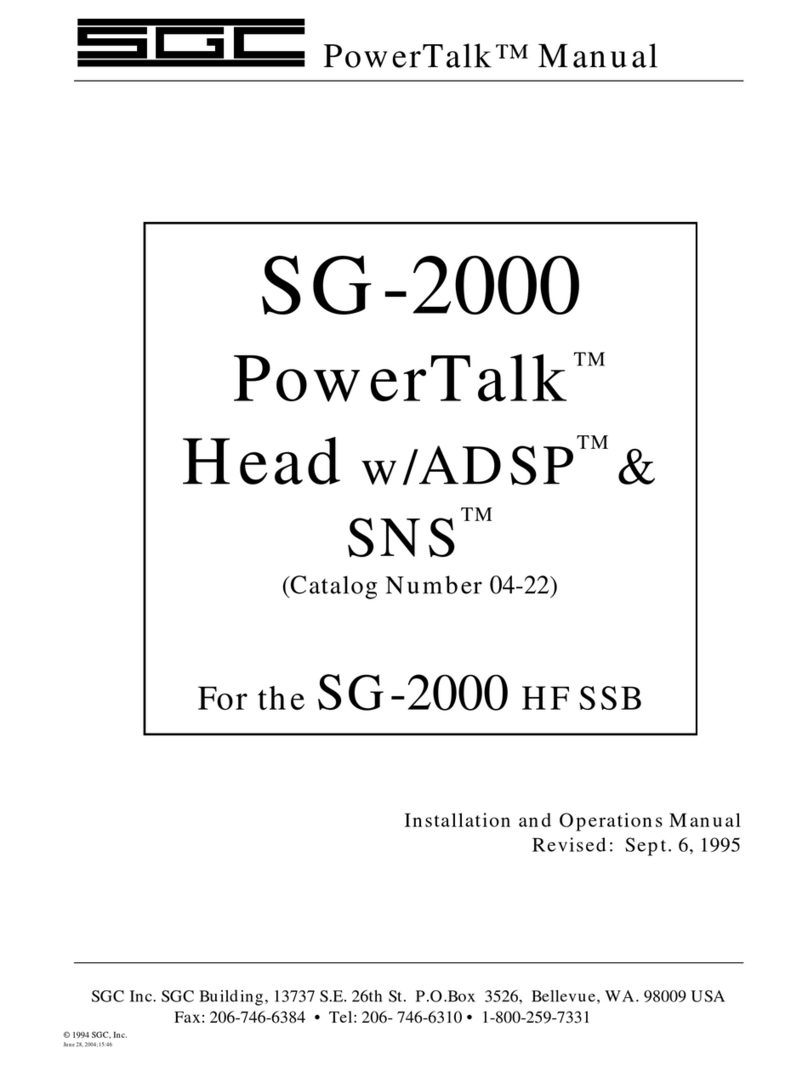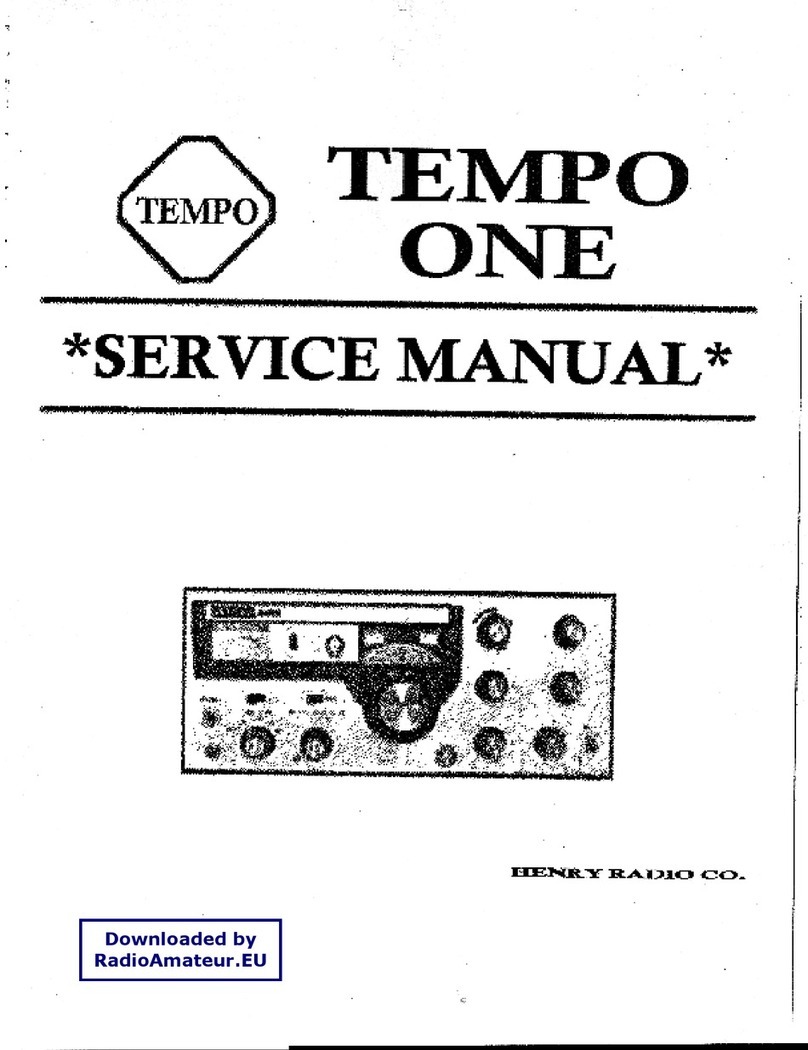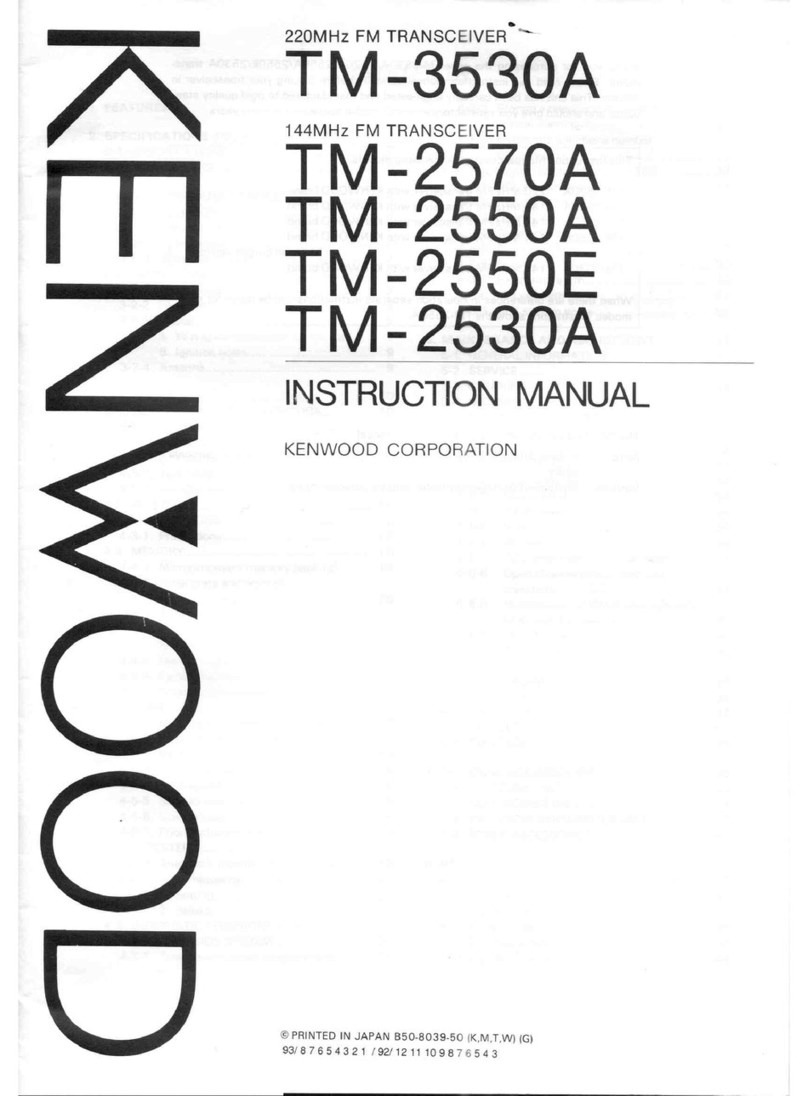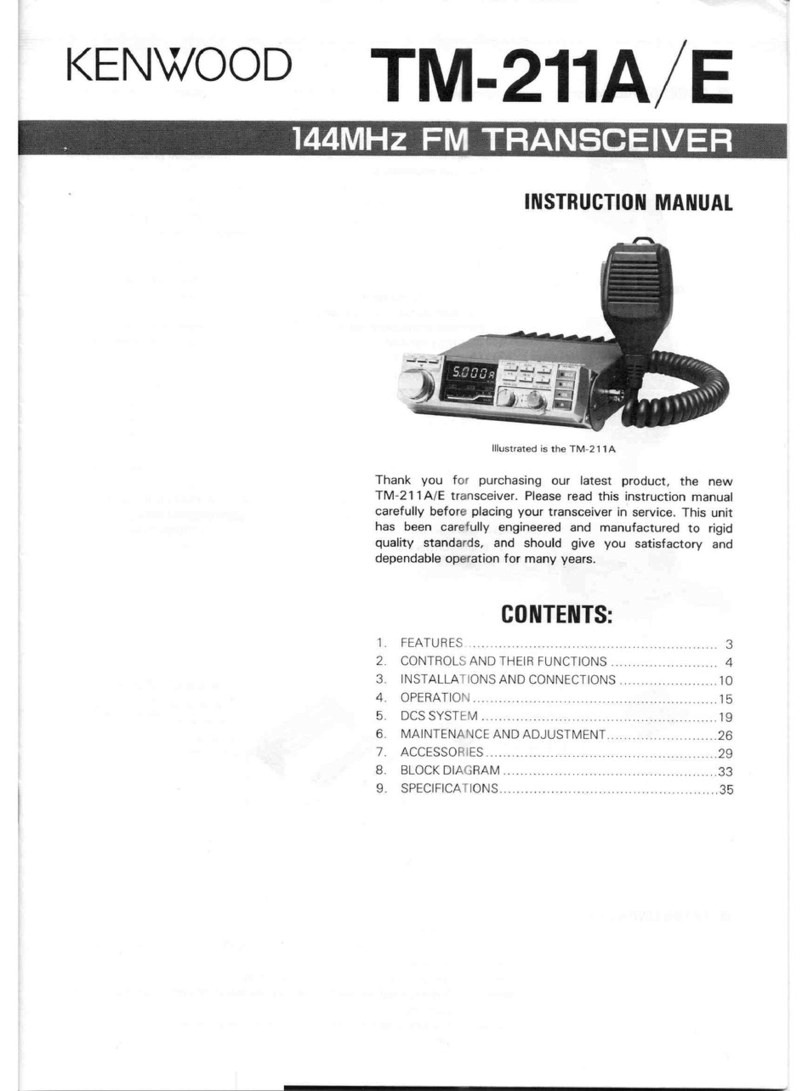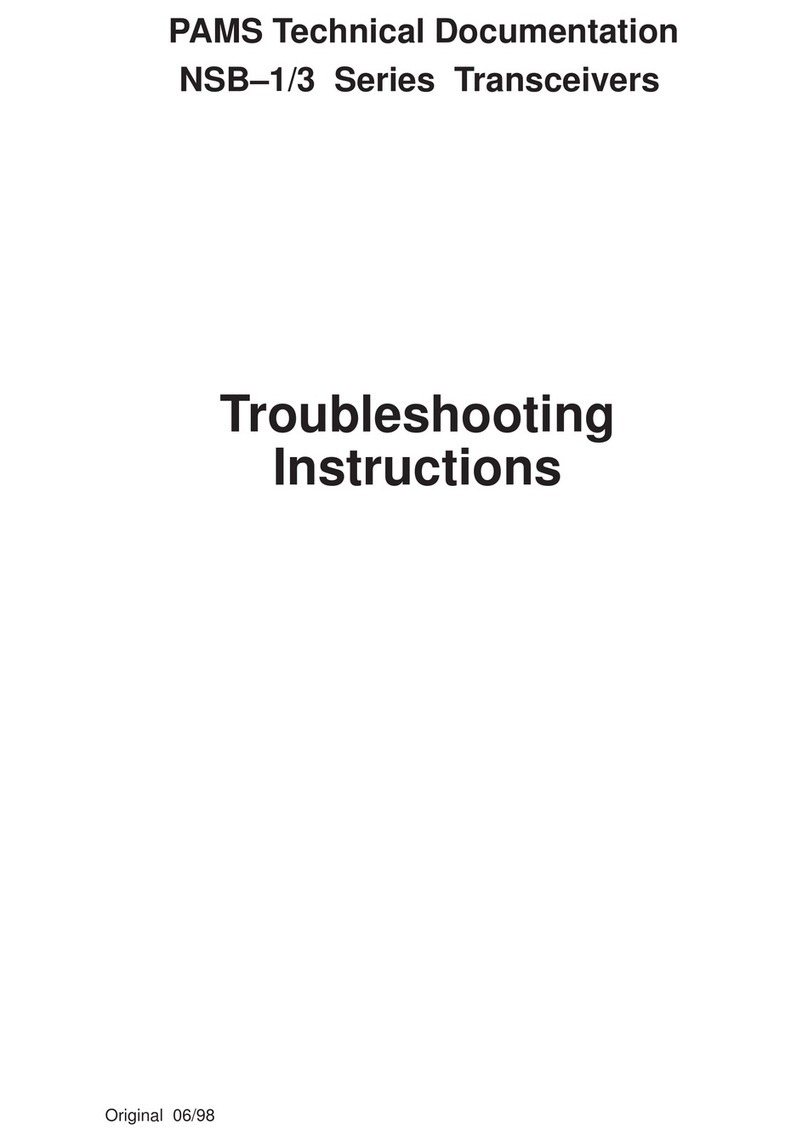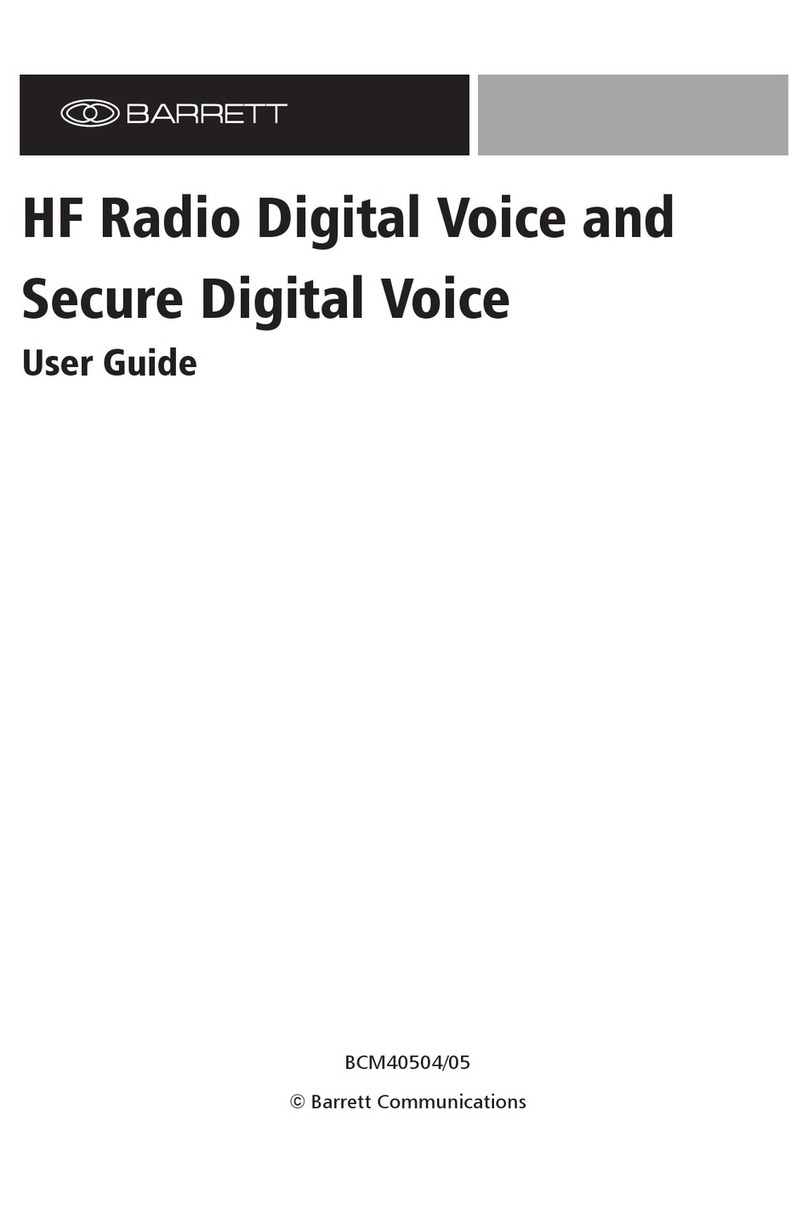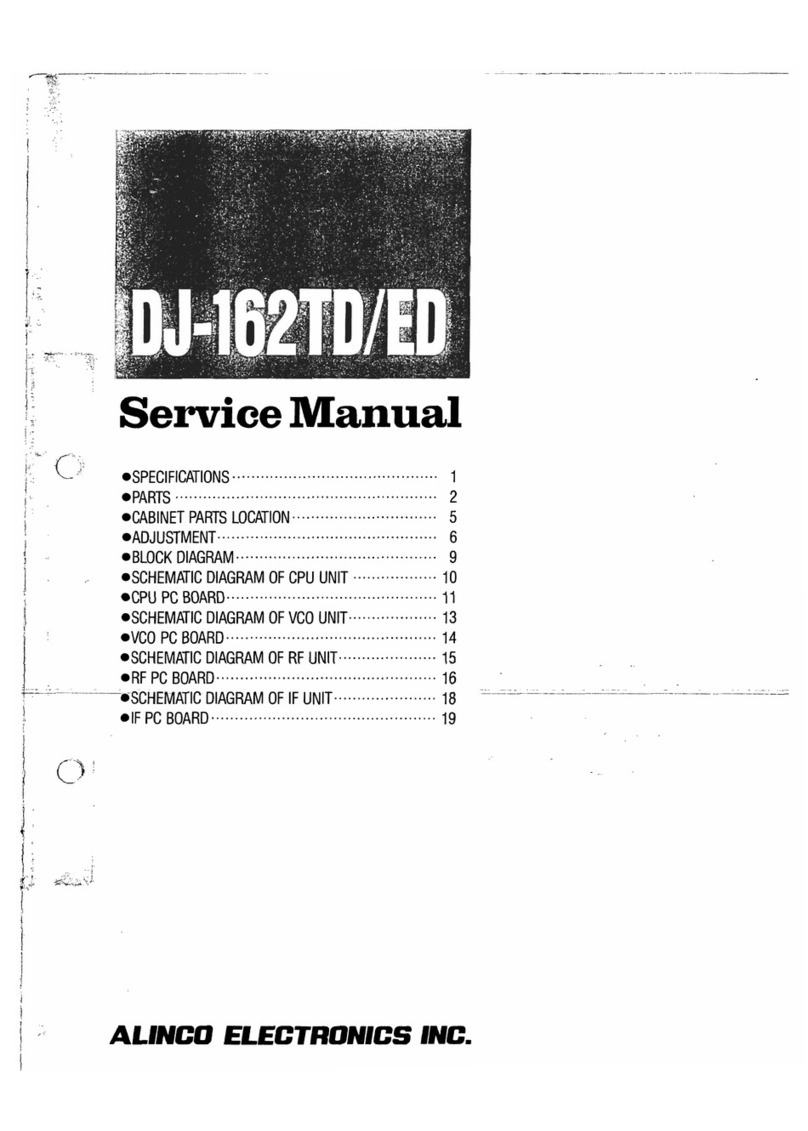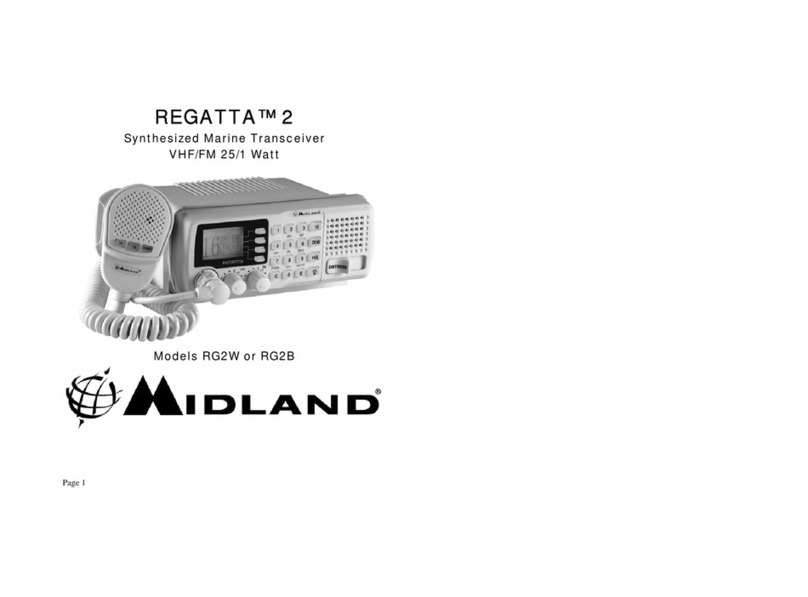Icom IC-775 User manual

o
ICOM
SERVICE
MANUAL
Icbm Inc.

INTRODUCTION DANGER
This service manual describes the latest service information for
the IC-775/DSP HF ALL BAND TRANSCEIVER at the time of
publication.
5versions of the IC-775DSP and 5versions of the IC-775 have
been designed. This service manual covers each version.
MODEL VERSION NO. VERSION SYMBOL
IC-775DSP
#02 Other OTH
#03 Spain ESP
#04 France FRA
#05 Germany FRG
#07 Europe EUR
IC-775
#12 Other OTH-1
#13 Spain ESP-1
#14 France FRA-1
#15 Germany FRG-1
#17 Europe EUR-1
To upgrade quality, any electrical or mechanical parts and
internal circuits are subject to change without notice or
obligation.
Use ONLY the specified AC voltage described on the AC
power socket. Other voltage may cause the transceiver
damage or personal injury.
DO NOT touch the REG unit after the transceiver is connected
to an AC outlet. An insulated tool must be used at all time.
DO NOT expose the transceiver to rain, snow or any liquids.
DO NOT apply an RF signal of more than 20 dBm (100 mW)
to the antenna connector. This could damage the
transceiver's front end.
Danger of explosion if alithium battery is incorrectly replaced.
Replace only with the same or equivalent type recommended
by the battery manufacturer.
Dispose of used batteries according to the manufacturer's
instructions.
Explosionsqefahr bei unsachgemaBen Austaush der Batterie.
Ersatz nur durch denselben oder einen vom Hersteller
empfohlenen ahniichen Typ. Entsorgung gebrauchter
Batterein mach Angaben des Herstellers.
ORDERING PARTS REPAIR NOTES
Be sure to include the following four points when ordering 1
.
replacement parts:
2
1.10-diglt order numbers
2. Component part number and name ^
3. Equipment model name and unit name
4. Quantity required ^
<SAMPLE ORDER>
1110003140 S.IC NJM4558M(T1) IC-775 MAIN UNIT Spieces 5.
8810004620 Screw PHM4x8ZK IC-775 Topcover 10 pieces
Addresses are provided on the inside back cover for your 6.
convenience.
7.
8.
Make sure aproblem is internal before disassembling the
transceiver.
DO NOT open the transceiver until the transceiver is
disconnected from its power source.
DO NOT force any of the variable components. Turn them
slowly and smoothly.
DO NOT short any circuits or electronic parts. An insulated
tuning tool MUST be used for all adjustments.
DO NOT keep power ON for along time when the
transceiver is defective.
DO NOT transmit power into asignal generator or asweep
generator.
ALWAYS connect a50 dB to 60 dB attenuator between
the transceiver and adeviation meter or spectrum analyzer
when using such test equipment.
READ the instructions of test equipment thoroughly before
connecting equipment to the transceiver.

TABLE OF CONTENTS
SECTION 1SPECIFICATIONS 1-1
SECTION 2DISASSEMBLY AND OPTION INSTALLATIONS 2-1to 5
2-1DISASSEMBLY INSTRUCTIONS 2-
1
2-2OPTION INSTALLATIONS 2-2
SECTION 3INSIDE VIEWS 3-1 to 2
SECTION 4CIRCUIT DESCRIPTION 4-1to 13
4-1 RECEIVER CIRCUITS 4-1
4-2TRANSMITTER CIRCUITS 4-5
4-3 PLL CIRCUITS 4-8
4-4ANTENNA TUNER CIRCUITS 4-9
4-5 LOGIC CIRCUITS 4-11
4-
6DSP CIRCUITS 4-13
SECTION 5ADJUSTMENT PROCEDURES 5-1 to 14
5-
1
PREPARATION BEFORE SERVICING 5-
1
5-
2PLL ADJUSTMENT 5-2
5-3 RECEIVER ADJUSTMENT 5-4
5-4TRANSMITTER ADJUSTMENT 5-8
5-5TUNER UNIT ADJUSTMENT 5-14
SECTION 6PARTS LIST 6-1to 35
SECTION 7MECHANICAL PARTS 7-1to 7
SECTION 8SEMI-CONDUCTOR INFORMATION 8-
1
SECTION 9BOARD LAYOUTS 9-1to 13
9-1DSP UNIT (IC-775DSP only) 9-
1
9-2SW-A UNIT 9-2
9-3SW-B AND DISPLAY UNITS 9-4
9-4 VR-AUNIT 9-5
9-5 MAIN UNIT 9-6
9-6 RFUNIT 9-7
9-7 IF UNIT 9-8
9-8 PLL UNIT 9-9
9-9 PA UNIT 9-10
9-10 FILTER UNIT 9-11
9-11 CTRL UNIT 9-12
9-12 RELAY UNIT 9-13
SECTION 10 VOLTAGE DIAGRAM /BLOCK DIAGRAM 10-1 to 6

SECTION 1SPECIFICATIONS
GENERAL
•Frequency coverage:
Receive 100 kHz -29.990 MHz
Transmit 1.800- 1.999999 MHz*'
3.500- 3.999999 MHz*'
7.000-
7.300 MHz*'
10.100 -10.150 MHz
14.000
-
14.350 MHz
18.068 -18.168 MHz
21.000-
21.450 MHz
24.890 -24.990 MHz
28.000 -29.700 MHz
*' 1.830-1 .850 for Spain version;
1.81 0-1 .850 for France version;
1.81 5-1 .835/1 .850-1 .890 for
Germany version
*' 3.500-3.800 for Spain, France and
Germany versions
*'7.000-7.100 for Spain, France and
Germany versions
•Mode :SSB, CW, RTTY, AM, FM
•Number of memory :101 (99 regular, 2scan edges)
channels
•Antenna impedance :50 Qnominal
•Usable temperature :-10°C to +60°C
;
range +14°F to +140T
•Frequency stability :Less than ±200 Hz from 1min, to
60 min, after power ON.
After that, rate of stability change is less
than ±30 Hz/hr. at +25t!: +77T.
Temperature fluctuations (OTD to
+50X:; +32T to +122 ”F) less than
±350 Hz.
•Power supply requirement:
120Vtype 100-120VAC
230 Vtype 220 -240 VAC
•Power consumption :
Transmit max. power 760 VA
Receive squelched 140VA
max. audio output 150 VA
•Dimensions :424(W) x150(H) x390(D) mm
1611/16(W) x5M/32(H) X1511/32(0)'
(projections not included)
•Weight :16.5 kg; 36.4 lb (without DSP unit)
16.7 kg; 36.8 lb (with DSP unit)
TRANSMITTER
•Output power :SSB, CW, RTTY, FM 5-200 W
AM 5-50 W
(continuously adjustable)
•Spurious emissions :Less than -60 dB
•Carrier suppression :More than 40 dB
•Unwanted sideband :More than 55 dB
•Microphone :600 Q
impedance
RECEIVER
•Receive system
SSB, CW, RTTY, Quadruple-conversion
AM superheterodyne
FM Triple-conversion superheterodyne
•Intermediate frequencies: (Unit: MHz)
MODE SSB CW, RTTY AM FM
1st 69.0100
2nd 9.0115 9.0106 9.0100
3rd 0.455 0.455 0.455 0.455
4th 10.6950 10.6950 10.6950 -
•Sensitivity (Preamp 1ON):
SSB, CW, RTTY 100 -500 kHz Less than 2.0 pV
(lOdBS/N) 1.8 -29.99 MHz Less than 0.16 pV
AM(l 0dBS/N) 0.5 -1.8 MHz Less than 13.0 pV
1.8 -29.99 MHz Less than 2.0 pV
FM (12 dB SINAD) 28 -29.99 MHz Less than 0.5 pV
•Squelch sensitivity (Preamp 1ON):
SSB, CW, RTTY, Less than 3.2 pV at threshold
AM
FM Less than 0.32 pV at threshold
•Selectivity (Normal filter selection):
SSB More than 2.4 kHz/ -6dB
Less than 4.0 kHz/ -60 dB
CW, RTTY More than 500 Hz/ -6dB
Less than 1.0 kHz/ -60 dB
AM More than 6.0 kHz/ -6dB
Less than 20.0 kHz/ -60 dB
FM More than 15.0 kHz/- 6dB
Less than 30.0 kHz/ -60 dB
•Spurious and image :More than 70 dB
rejection ratio
•Audio output power :More than 2.6 Wat 10% distortion
with an 8Qload
•RIT/ZITX :±9.999 kHz
variable range
ANTENNA TUNER
•Matching impedance range:
16.7-150Q unbalanced
(Less than VSWR 3:1)
•Minimum operating :8W
input power
•Tuning accuracy :VSWR 1.5:1 or less
•Insertion loss :Less than 1.0 dB
(after tuning)
All stated specifications are subject to change without notice or obligation.
1-1

SECTION 2DISASSEMBLY AND OPTION INSTALLATIONS
2-1 DISASSEMBLY INSTRUCTIONS
•TOP AND BOTTOM COVERS •PA UNIT
©Remove 6screws from the transceiver’s top and 40Disconnect the piug (P1) from J8 on the RF unit (bottom
screws from the sides, then remove the top cover. side).
®Turn the transceiver upside down. @Disconnect the plug (W1 )and flat cables (W4, W7) from
@Remove 8screws from the bottom cover, then remove the TUNER unit.
the bottom cover. (D Remove 2screws [e] and 1screw [f] to remove the PA
•REG UNIT •TUNER UNIT
©Remove 2screws [U to remove the speaker.
@Remove 2screws B, 2screws ®and 2screws B.
©Push the position “A” and pull the position “B” to release
2hooks.
©Disconnect 2connectors from the REG unit’s front and 1
connector (cable from the REG unit) from the front block,
then remove the REG unit.
©Disconnect the connector (P1) from J24 on the IF unit
(bottom side).
@Remove 1screw S] and 1screw El to remove the
TUNER unit.
2-1

•FRONT BLOCK
©Remove 3screws Q].
®Remove 2screws Q] and 2screws B, then remove the
right and left angles.
@Separate the front block and main chassis.
2-2 OPTION INSTALLATIONS
•UI-100 DSP UNIT
The UI-100 DSP UNIT provides noise reduction, DSP
modulation/demodulation, DSP filters, auto notch, auto
APF, etc. for the IC-775. The IC-775DSP has aDSP unit
as standard.
Install the DSP unit as follows:
©Remove the top cover as described on p. 2-1
.
©Connect the 3plugs (attached to the backside of the
front panel) to the appropriate connectors as shown
below.
m
(D Insert the DSP unit into the slots at the backside of the
main and sub dials.
0Tighten the 2supplied screws as shown below.
(D Replace the top cover.
I
After installation, read the instruction manual as for a
“DSP-equipped type” transceiver. The [AF LPF] switch
functions as the auto notch switch in SSB mode and the
auto APF switch in CW mode.
2-2

•OPTIONAL FILTER
After installing optional filters, the transceiver has 3* kinds
of selectivity for 2nd and 3rd IF filters to provide better S/N
(signal-to-noise ratio), or to reject nearby interference.
*FM mode: 2kinds of selectivity
Following optional filters are available.
IF Filter Passband width Used selectivity
2nd
FL-101 250 Hz/-6dB CW nar.
FL-102 6.0 kHz/-6dB SSB wide,
AM med., FM nar.
FL-223 1.9 kHz/-6 dB SSB nar.
3rd FL-53A 250 Hz/-6dB CW nar.
FL-222 1.9 kHz/-6 dB SSB nar.
When only 1filter is installed for selectivity, such as a
FL-101 installed but no FL-53A installed, optimum perform-
ance cannot be obtained for the selectivity and the twin
PBT function does not operate correctly. Both filters, such
as FL-101 and FL-53A, should be installed.
FILTER SELECTION
After the filter(s) are installed, activate the optional
mfilter(s) in H-set mode. If this is not correctly set, the
^installed filter(s) cannot be selected.
I
®Remove the top and bottom covers as described on
p. 2-1.
@Insert the filter(s) to the proper position. The locations
are shown in the figures below.
-The FL-53A and FL-222 must be installed in the proper
direction.
-The FL-101, FL-102 or FL-223 work regardless of the
direction they are installed in.
d) Replace the top and bottom covers.
FL-102 (or FL-101, FL-223) Installation
•UT-66 VOICE SYNTHESIZER UNIT
The UT-66 announces the operating frequency or selected
mode in aclear, electronically-generated voice (in English
or Japanese).
®Remove the top cover as described on p. 2-1
.
(D Plug the UT-66 into J1 on the MAIN unit (backside of
the S/RF meter) as shown in the figure at right.
@Replace the top cover.
0Set the language and speech speed in H-set mode.
2-3

CR-282 HIGH-STABILITY CRYSTAL UNIT
By replacing the original crystal unit with this unit, the total
frequency stability of the transceiver will be improved.
CR-282 frequency stability:
±0.5 ppm (-30°C to -i-60°C: -22T to -M40T)
®Remove the top and bottom covers as described on
p. 2-1.
(D Remove 10 screws from the PLL unit and the ribbon
cabie from J11; then turn over the PLL unit to see the
reverse side. (Fig. 1)
d) Unsoider the leads of the installed crystal, then remove
the crystal.
-Use adesoldering braid.
@Unsolder the 4positions on the PLL unit where the
CR-282 will be installed.
(D Install the CR-282 in the PLL unit, paying attention to
orientation.
-Symbols on the bottom of the CR-282 must be identically
matched with symbols on the P.C. board.
(D Bend the leads of the CR-282 at the foil side of the P.C.
board and soider them as shown in figure 2at right.
®Trim the ieads even with the soider points.
(D Replace the PLL unit, ribbon cabie and covers.
After changing the crystal unit, frequency adjustment is
necessary with L4 on the PLL unit.
-Refer to p. 5-2 for adjustment details.
NOTE: The CR-282 is an oven-heat-type crystal unit, and
the specified frequency stability described above is guar-
anteed 1min. after power ON.
Ribbon cable
(Fig. 1)
Solder points
(Fig. 2)
2-4

•AC VOLTAGE SELECTION
iAWARNING: DISCONNECT the AC power
Pcable from the transceiver and wait afew minutes
^before seiecting an AC power voltage.
The regulator unit in the IC-775/DSP can be switched to
120 or 230 VAC.
®Remove the REG unit as described on p. 2-1
.
(2) Remove the 16 screws to remove the internal shield
cover of the regulator unit.
(D Unplug the cable as shown in the diagram below, then
connect it to the desired voltage position.
@Change the AC fuse to an appropriate one.
©Replace the internal shield cover and plug in the 3
power connectors. Replace the regulator unit, then
check the movement of the [POWER] switch. Replace
the remaining units, covers and screws.
AWARNING: DO NOT forget to change the
AC fuse when you change the AC input voltage. An
incorrect fuse may pose afire hazard.
-12 AFGMB fuse for 100-120 Vversions
-5Ahigh breaking capacity fuse for 220-240 Vversions
•BACKUP BATTERY REPLACEMENT
The transceiver has alithium backup battery on the inside
of the front panel (MAIN unit) for retaining operating
conditions. The usual life of the backup battery is approxi-
mately 5years.
When the backup battery is exhausted, the transceiver
transmits and receives normally but cannot retain oper-
ating conditions except for memory channels.
PCAUTION: If the lithium battery is incorrectly re-
Pplaced, it could explode. Replace with aCR-2032 or
pequivalent type.
®Remove the top and bottom covers as described on
p. 2-1.
®Remove 8screws from the front panel as shown in
figure 1at right.
@Remove the front panel.
®Replace the backup battery as shown in figure 2at
right.
®Reassemble the front panel.
-Check that the [POWER] switch works smoothly.
®Replace the top and bottom covers.
PCAUTION: After replacing the lithium battery, turn
Ppower ON and OFF, otherwise, the lithium battery will
pbecome exhausted rapidly.
Topside :©
Bottom side :©
(© terminal is visible after installation.)
(Fig. 2)
2-5

SECTION 3INSIDE VIEWS
•BOTTOM VIEW
3-1

r
•TOP VIEW
3-2
CTRL
unit

SECTION 4CIRCUIT DESCRIPTION
4-1 RECEIVER CIRCUITS
4-1-1 RF SWITCHING CIRCUIT
(CTRL AND RF UNITS)
The RF switching circuit leads receive signals to bandpass
filters from an antenna connector while receiving. While
transmitting, this circuit leads the signals from the RF power
amplifier to the antenna connector.
RF signals from an antenna connector, pass through the
antenna selecting relay (RL3), transmit/receive switching
relays (RL1, RL2, RL4, RL12) and low-pass filter (LI 5, Li 6,
C48-C50), and are then applied to the RF unit via J10 (RF
unit J7-1).
The signals from the CTRL unit are either bypassed or are
applied to the 6dB (R132, RL2) and/or 12 dB attenuators
(R131, RL1). By selecting the attenuators, 0(bypass), 6,
12 and 18 dB attenuations are obtained. The signals are
then applied to RF filters.
4-1-2 RF BANDPASS FILTER CIRCUIT
(RF UNIT)
RF bandpass filters pass only the desired band signals and
suppress any undesired band signals. The RF circuit has 9
bandpass filters and 2low-pass filters.
(1)0.1-0.5 MHz
The signals pass through alow-pass filter (L84-L86, C141-
C1 45), bypass the preamplifiers and are then applied to the
RF amplifiers (Q7, Q14).
(3) 1.6-30.0 MHz
The signals pass through ahigh-pass filter (L134, LI 35,
Li 37, C226-C229) to suppress strong signals below 1.6
MHz. The filtered signals are applied to one of 9bandpass
filters as below, aPIN attenuator (D42), and then applied to
or bypassing the preamplifier circuit.
Used RF filter
Band Control
signal
Input
diode Band Control
signal
Input
diode
0.1-0.5 MHz B1 019(1/2) 6-8 MHz
0.5-1.6MHz B2 019(1/2) 8-1 1MHz KM
1.6-2 MHz B3 11-15 MHz 027(1/2)
2-3 MHz B4 15-22 MHz
3-4 MHz B5 023(1/2) 22-30 MHz
4-6 MHz B6 025(1/2)
4-1-3 PREAMPLIFIER CIRCUITS (RF UNIT)
(1 .6 MHz and above)
The IC-775/DSP has 2gain levels of preamplifier circuits.
One has 10 dB gain over awideband frequency range and
the other has 16dB gain for 21 -28 MHz Jbands.
When the [PREAMP/ATT] switch is set to [PRE1] or [PRE2],
the signals above 1.6 MHz are applied to the preamplifier 1
(Q22, Q23) or preamplifier 2(Q24, Q25) circuit, respec-
tively. Amplified or bypassed signals are applied to the 1st
mixer circuits.
4-1-4 RF AMPLIFIER AND 1st MIXER
CIRCUITS (RF UNIT)
(2) 0.5-1 .6 MHz
The signals pass through a10 dB attenuator (R117) to
prevent distortion caused by very strong signals and are
then applied to alow-pass filter (L88, L89, C148-C150).
The filtered signals bypass the preamplifiers and are then
applied to the RF amplifiers (Q7, Q14).
•RECEIVER CONSTRUCTION
The 1st mixer circuit mixes the receive signals with the 1st
LO signal to convert the receive signal frequencies to a69
MHz 1st IF. The IC-775/DSP has two 1st mixer circuits for
the dualwatch function.
The signals from the preamplifier circuit, or signals which
bypass the preamplifiers, are divided at L52. Each signal is
applied to a30 MHz cut-off low-pass filter, RF amplifier (Q7
or Q1 4) and then to a1st mixer (Q5/Q6 or Q1 2/Ql 3).
RF unit
FI1a/FMb
,Crystal i
\fiitef /
89.0115 MHz
1st mixer A
Q12, Q13
IstLO A:
69.1115-99.0015 MHz
IF unit
2nd mixer FI2 or 3rd mixer
IC34 FI3 IC1S FM-FI7
9.0115 MHz
LCeramic
it
To FM detector (IC1 5)
4th mixer
IC13
Product
detector/
XI 5th mixer IC14
455 kHz
ToAF
selector
switch
2nd LO: 60.0 MHz 3rd LO: 9.4685 MHz 4th LO: 11.15 MHz BFO :10.7 MHz
(DSP receive OFF)
5th LO :10.715 MHz
(DSP receive ON)
4-1

Each 1st LO signal
(69.1115-99.0015 MHz)
enters the RF unit from the
PLL unit via PI or P2. The
LO signals are amplified at
Q1 or Q8, filtered by alow-
pass filter, and then,
applied to each 1st mixer.
1st IF frequency
Mode Frequency
SSB 69.0115 MHz
CW, RTTY 69.0106 MHz
AM, FM 69.0100 MHz
The detected voltage is also applied to the noise blanker
AGO circuit (Q52) and is then fed back to the noise ampli-
fiers (Q47-Q49) as abias voltage. The noise AGO circuit
prevents closure of the noise blanker gate for long periods
by non-pulse-type noise. The time constant of the noise
blanker AGO circuit is determined by R55 and C41 .Q54-
Q56 expand the blank width when [NB WIDE] is turned ON.
The [BLK-WIDTH] control adjusts the blank width.
4-1-5 1st IF CIRCUIT (RF UNIT) The signals from the noise blanker gate are then applied to
the 2nd IF circuit.
The 1st IF circuit filters and amplifies the 1st IF signals. The
1st IF signals combined at L34 are applied to an MCF
(Monolithic Crystal Filter; FI1) to suppress out-of-band
signals.
The levels of the converted 1st IF signals are adjusted at
PIN attenuators (D1, D3, D4 and D5, D7, D8) controlled by
the [BALANCE] control. The signals are applied to a1st IF
amplifier (04 or 01 1) and then combined at L34.
The combined signals pass through the pair of MCF’s (FI1)
and are amplified at 015. The signals are applied to the
2nd mixer (IC34) in the IF unit via P3 (IF unit J8). The AGC
voltage is supplied to the 2nd gate of Q15.
4-1-6 2nd MIXER CIRCUIT (IF UNIT)
The 2nd mixer circuit mixes the amplified 1st IF signals and
2nd LO signal (60.00 MHz) to convert the 1st IF to a2nd IF.
The 1st IF signals from the RF unit are converted to 9MHz
2nd IF signals at the 2nd mixer (IC34).
The 2nd IF signals are 2nd IF frequency
applied to FI1 to suppress
undesired signals such as
the 2nd LO signal, and are
then applied to the noise
blanker gate (D68-D71).
Mode Frequency
SSB 9.0115 MHz
CW, RTTY 9.0106 MHz
AM, FM 9.0100 MHz
4-1-7 NOISE BLANKER CIRCUIT (IF UNIT)
The noise blanker circuit detects pulse type noise, and turns
OFF the signal line when noise appears.
The 2nd IF signals from FI1 are applied to the noise blanker
gate (D68-D71). Aportion of the signals from FI1 are
amplified at the noise amplifiers (Q47-Q49), then detected
at the noise detector (D75) to convert the noise components
to DC voltages.
The signals are then applied to the noise blanker switch
(Q57-Q59). At the moment the detected voltage exceeds
the Q59’s or Q58’s threshold level, Q57 outputs ablanking
signal to close the noise blanker gate (D68-D71) by apply-
ing reverse-biased voltage. Q58 and Q59 are activated by
narrow-width pulses and high level pulses, respectively. The
[NB LEVEL] control adjusts the threshold level of Q58 and
Q59.
4-1-8 2nd IF CIRCUIT (IF UNIT)
The 2nd IF circuit amplifies and filters the 2nd IF signals.
The signals passed through the noise blanker gate
(D68-D71) are amplified at Q46 and applied to a2nd IF
filter as shown in the following table.
2nd IF filters
Mode Used filter Control signal
CW/RTTY wide,
SSB med., AM nar. FL-80 (FI2) 2N24
CW/RTTY med. FL-32A (FI3) 2N05
CW/RTTY nar. Optional FL-1 01 2NCO
SSB wide, AM med.,
FM nar. Optional FL-1 02 2NAO
SSB nar. Optional FL-223 2NSO
AM wide, FM med. Bypassed 2NTH
The filtered or bypassed signals are then applied to the 3rd
mixer circuit through abuffer amplifier (Q38).
4-1-9 3rd MIXER AND 3rd IF CIRCUITS
(IF UNIT)
The 3rd mixer circuit mixes the 2nd IF signals and the 3rd
LO signal to obtain the 3rd IF (455 kHz) signals.
The 2nd IF signals from Q38 are applied to the 3rd mixer
(IC18 pin 6). The 3rd LO signal from the PLL unit is applied
to the 3rd mixer (IC18 pin 8). The 2nd IF signals are
converted to 3rd IF signals. The 3rd IF signals are ampli-
fied at Q39, and then applied to one of the 3rd IF filters.
3rd IF filters
Mode Used filter Control signal
CW/RTTY wide,
SSB med., AM nar. FL-96 (FI4) 3R26
CW/RTTY med. FL-52A (FI5) 3R05
SSB wide, AM med.,
FM nar. CFW455HT (FI6) 3R60
AM wide, FM med. CFW455E (FI7) 3RFM
CW/RTTY nar. Optional FL-53A 3RCO
SSB nar. Optional FL-222 3RSO
4-2

The filtered signals are amplified at Q12, and then applied
to the 4th mixer or FM detector circuit.
4-1-10 4th MIXER AND 4th IF CIRCUITS
(IF UNIT)
The 4th mixer circuit mixes the 3rd IF signals and the 4th
LO signal to obtain the 4th IF (10.6950 MHz) signals.
The 3rd IF signals from Q12 are applied to the 4th mixer
(IC13 pin 6), except in FM mode, and are mixed with the 4th
LO signal to be converted into 4th IF signals. The 4th IF
signals are applied to the IF notch filter (XI), filtered at FIS
and then amplified at Q13 and Q14. R198 sets the total
gain.
The 4th IF signals are applied to the AM detector circuit via
the buffer-ampiifier (Q15) or product detector (IC14 pin 6).
IC14 functions as the 5th mixer when the DSP (Digital
Signal Processor) receive function is turned ON.
4-1-11 TWIN PBT CIRCUIT (IF UNIT)
The PBT (PassBand Tuning) circuit shifts the center fre-
quency of IF signals to electronically narrow the passband
width. The IC-775/DSP has 2PBT circuit.
The twin PBT circuit shifts the 2nd and 3rd IF within ±1.5
kHz. As aresult, the 2nd and 3rd IF are shifted from the
center frequencies of the 2nd and 3rd IF filters. This means
2nd or 3rd IF signals do not pass through the center of the
2nd or 3rd IF filters because the passband width is fixed in
the 2nd or 3rd IF filter. Therefore, the overlap of the
2nd/3rd or 3rd/4th IF filter appears to be narrowed. Since
the 3rd and 4th LO frequencies are also shifted the same
value as the 2nd and 3rd IF shifts, frequencies are cor-
rected at the detector.
In the IC-775/DSP, the 1st LO frequency is shifted to
change the 2nd IF because afixed 2nd LO frequency (60
MHz) is used. The 1st IF filter (RF unit FM) and crystal filter
(IF unit FI1) have 15 kHz passband widths and do not affect
PBT operation.
4-1-12 IF NOTCH CIRCUIT (IF UNIT)
The IF notch circuit attenuates aspecified audio frequency
in the IF section to increase readability of desired signals.
The IF signals from the 4th mixer (1013) are appiied to the
IF notch circuit (XI). The crystal filter has excellent cut-off
frequency characteristics and attenuation of more than 45
dB. The IF notch frequency is controlied by shifting the 4th
IF to obtain the same attenuation characteristics within the
IF band width. The 4th IF frequency can be adjusted with
the [NOTCH] control.
When the [NOTCH] switch is turned OFF, the 4th IF signals
pass through XI out of the notch filtering frequency. There-
fore, the IF notch circuit is substantially bypassed by the 4th
IF signals.
4-1-13 AGC CIRCUIT (IF UNIT)
The AGC (Automatic Gain Control) circuit reduces IF ampli-
fier gain to keep the audio output at aconstant level.
The receiver gain is determined by the voltage on the AGC
line (Q17 collector). Q26 supplies minus voltage to the
AGC line and sets the receiver gain with the [RF] control.
The 4th IF signal from the buffer amplifier (Q15) is detected
at the AGC detector (DIO) and is then applied to the DC
amplifier (Q17). -5 Vis applied to the Q17 emitter to
activate the AGC line using minus voltage.
When receiving strong signals, the detected voltage in-
creases and the AGC voltage decreases via the DC ampli-
fier (Q17). As the AGC voltage is used for the bias voltage
of the IF amplifiers (Q13, Q14, Q39, Q46 and RF unit Q15),
IF amplifier gain is decreased. The AGC voltage is also
applied to the PIN attenuator (D42) in the RF unit to
attenuate the received signals before the 1st mixers.
When the strong signal disappears, the AGC line voltage is
released by C146-C148 and R222 while in SSB, CW and
RTTY mode. While In AM or FM mode, Cl 45 or R221 is
connected in parallel to obtain appropriate AGC character-
istics, respectively.
AGC circuit *Qc AM FM
OFF mod* mode AGC line
4-1-14 S-METER CIRCUIT (IF UNIT)
The S-meter circuit indicates the relative received signal
strength while receiving by utilizing the AGC voltage which
changes depending on the received signal strength.
The AGC bias voltage (time constant line) is applied to a
differential amplifier (IC7b pin 6) where the difference be-
tween the AGC and reference voltages is detected.
The resulting S-meter signal passes through the meter
switching circuit (IC6 pins 3, 13) via the “SQLV” signal line.
The S-meter signal is applied to the main CPU, sub CPU,
and then to the S/RF meter on the front panel.
The S-meter signal (SQLV) is also applied to the main CPU
(MAIN unit IC12 pin 93) for S-meter squelch detection.
4-1-15 SQUELCH CIRCUIT
(MAIN, IF AND SW-A UNITS)
4-3
The squelch circuit mutes audio output when the S-meter
signal is lower. than the [SQL] control setting level.

The S-meter signal is applied to the main CPU (MAIN unit
IC1 2pin 93) and is compared with the threshold level set by
the [SQL] control. The [SQL] setting Is picked up at the A/D
converter (SW-A unit IC7) and then applied to the sub CPU
(ICS). The CPU compares the S-meter signal and [SQL]
setting to close or open the squelch.
In addition, the noise squelch signal (FMND) from the FM IF
1C is applied to the main CPU (pin 92) in FM mode. A
portion of the AF signals from the FM IF 1C (IF unit IC15, pin
9) are applied to the active filter section (pin 8) where noise
components above 20 kHz are amplified. The signals are
rectified at the noise detector section and then output from
pin 13. The resulting signal is applied to the main CPU via
the “FMND/ASQN" signal line.
4-1-16 SSB/CW DEMODULATOR CIRCUIT
(IF UNIT)
While in SSB or CW mode (DSP detection is QFF), the 4th
IF signals from Q14 are mixed with the BFO signal from the
PLL unit at the product detector (IC14 pin 6). The detected
AF signal from IC14 (pin 2) is applied to the AF selector
switch (IC1 6, IC17).
4-1-17 AM DEMODULATOR CIRCUITS
(IF UNIT)
While in AM mode (DSP detection is OFF), the 4th IF
signals from the IF amplifier (Q14) are amplified at Q15 and
detected at D8. The detected AF signal is then applied to
the AF selector switch (IC16, IC17) via Q16.
4-1-18 FM DEMODULATOR CIRCUIT (IF UNIT)
While in FM mode, the 3rd IF signals from the buffer
amplifier (Q12) are applied to the FM IF 1C (IC15 pin 5)
where the IF signals are converted into AF signals. X2 is
used for quadrature detector. The detected AF signals are
then applied to the AF selector switch (IC16, IC17) via Q30
and Q31.
4-1-19 AF SELECTOR SWITCH (IF UNIT)
The AF signal from one of the detector circuits is applied to
the AF selector switch (IC16, IC17). IC16 and IC17 consist
of 8analog switches which are selected with amode signal
and the squelch control signal.
The AF signal is output from IC1 6(pin 3) and then applied
to the AF amplifier circuit in the MAIN unit. When the DSP
receive function is ON, the AF or 5th IF signal is output from
IC17 (pin 3), buffer-amplified at Q32 and then applied to the
DSP unit.
AF selector switch
IC16
4-1-20 APF AND AF LOW-PASS FILTER
CIRCUITS (MAIN UNIT)
The APF (Audio Peak Filter) boosts aspecified frequency to
pick up adesired CW signal, etc. The low-pass filter cuts
off higher audio frequencies.
When [APF] is turned ON, the AF signal from the AF
selector switch is applied to the APF circuit (IC1a pin 2).
The [APF] control adjusts the peak frequency within
200-1000 Hz. IC2 is atriple 2-channel analog switch 1C
and either applies the AF signal to the APF circuit or
bypasses the APF circuit.
When [AF LPF] or [AUTO] Is turned ON (deactivating the
DSP functions for DSP-equipped types), the AF signal from
the APF circuit is applied to the 1.5 kHz cut-off AF low-pass
filter (ICIb pin 5). IC2 either applies the AF signal to the
low-pass filter or bypasses the low-pass filter.
APF and low-pass filter circuits
AF signal
from IF unit
To AF amplifier
(IC24a)
Audio peak filter AF low-pass filter

4-1-21 AF AMPLIFIER CIRCUIT (MAIN UNIT)
The AF amplifier amplifies the AF input signal to asuitable
driving level for the speaker.
The AF signal from the AF low-pass filter (IC1 b) is applied
to the AF amplifiers (IC24a, IC7a). The CW side tone/
transmit monitor signal and beep tone are amplified at tC7b
and IC24b, respectively.
The amplified signals from IC7a, IC7b and lC24b are
applied to the [TONE] control (VR-A unit R32) and then to
the VGA (Voltage Controlled Amplifier, IC16) circuit. The
AF gain setting from the main CPU (pins 42-51) is con-
verted to DC voltage at R58-R77 and applied to the VGA
control terminal (IC1 6pin 8) via IC20a. The AF signal from
1C16 (pin 9) is power-amplified at IC6 to drive the speaker.
4-2-2 VOX CIRCUIT (MAIN UNIT)
The VOX (Voice-Operated-Transmission) circuit sets trans-
mitting conditions according to voice input.
The microphone signal from ICS pin 4passes through the
[VOX-GAIN] control (VR-A unit R45) and is amplified at
IC23b. The signal is then applied to the VOX comparator
(IC23d pin 13) to switch Q23, IC17, IC22, Q5. When voice
levels exceed the comparator level, the VOX circuit sets the
transceiver to transmit.
On the other hand, aspeaker drive signal from the AF
power amplifier (IC6) is applied to the antl-VOX comparator
(IC23a pin 3) via the [ANTI-VOX] control (VR-A unit R44).
When audio output level increases, this comparator cuts out
the VOX comparator input using 06.
4-2 TRANSMITTER CIRCUITS
4-2-1 MICROPHONE AMPLIFIER CIRCUIT
(MAIN AND IF UNITS)
The microphone amplifier circuit amplifies microphone input
signals and outputs the amplified signals to the balanced
modulator, DSP (PSN) modulation circuit or FM/AM modu-
lation circuit.
Audio signals from the [MIC] connector are amplified at
VCA 1C (IC8). The amplified signals from pin 4are applied
to the [MIC TONE] control (VR-A unit R43) and then to the
VCA section of IC8 (pin 7). The microphone gain setting
from the main CPU (pins 32-41) is converted to DC voltage
at R38-R57 and applied to the VCA control terminal (ICS
pin 8) via IC20b. The resulting signals from pin 9are then
applied to IClOa (IF unit) via the “MIG2” signal line. Exter-
nal modulation input from the [ACC(1 )] socket (pin 4) is also
applied to IClOa (IF unit).
The amplified signals from IClOa are then applied to the AF
selector switch (IC9) for SSB modulation or the amplifier
(IClOb) for FM/AM modulation.
When the DSP modulation Is turned ON, pins 3/5 and 13/14
of the AF selector switch (IC9) are connected. Therefore,
the amplified signal is applied to the DSP unit and the
resulting signal (15 kHz IF) is applied to the mixer (ICS) via
IC9.
4-2-3 BALANCED MODULATOR (IF UNIT)
The balanced modulator converts the AF signal from the
microphone amplifier to a455 kHz IF signal with aBFO
(Beat Frequency Oscillator) signal.
Microphone signals from the AF selector switch (IC9 pins 1
,
3) are applied to the balanced modulator (ICS pin 6). The
BFO signal from the PLL unit is applied to ICS (pin 8) as a
carrier signal.
ICS is adouble balanced mixer 1C and outputs adouble
side band (DSB) signal with -40 dB of carrier suppression.
R273 and R274 adjust the balanced level of ICS for maxi-
mum carrier suppression. The resulting signal passes
through the 455 kHz IF filter (FI4; FI6 when PSN modu-
lation) to suppress unwanted sideband signals.
When DSP modulation is turned ON, ICS functions as a
mixer. ICS mixes the 15kHz IF signal with a440 kHz LO to
obtain a455 kHz IF signal.
In CW and RTTY modes, IC9 pins 2and 3are connected to
upset the balance of ICS via R268 for leaking the BFO
signal as acarrier signal. CW keying is controlled at 01
0
via the “WFM4” signal.
.TRANSMITTER CONSTRUCTION
4-5

4-2-4 FM AND AM MODULATION CIRCUITS
(IF UNIT)
(1) While in FM mode
The microphone signals from ICfOa are amplified at IClOb
and pass through the limiter amplifier (ICIfa) and the
splatter filter (ICIIb). The subaudible tone signal (67.0-
254.1 Hz) from the PLL unit is also applied to ICIla pin 2
for repeater use.
The resulting signals are applied to the modulation circuit
(D65) via R292. The modulation circuit changes the reac-
tance of the local oscillator (Q44, X3) to obtain FM modu-
lation. The modulated signal is applied to the transmitter IF
amplifier (Q78) via IC1 2.
(2) While in AM mode
The microphone signals from ICIIb are applied to the
balanced modulator (IC12) and upset the balance to obtain
AM modulation. The local oscillator (Q44, X3) oscillates a
9.0115 MHz signal \with no FM modulation.
4-2-5 RF SPEECH COMPRESSOR CIRCUIT
(IF UNIT)
The RF speech compressor compresses the transmitter IF
signal to increase the average talk power.
When the [COMP] switch is ON, the IF signal from a455
kHz filter is buffer-amplified at 033 and is then applied to
the RF compressor circuit (035, D31). The resulting signal
is applied to the IF amplifier (036). The 2nd gate of 036 is
controlled by the [DRIVE] control (VR-A unit R22). When
the [COMP] switch is OFF, the IF signal bypasses the
compressor circuit via D27 and D29.
The resulting signal is mixed with 9.4665 MHz LO signal at
IC19 to obtain a9MHz IF signal.
4-2-6 IF AMPLIFIER (IF AND RF UNITS)
The 9MHz IF signal from IC19 passes through the 9MHz
IF filter (FI2) in CW/RTTY modes or in SSB mode with
[COMP] ON. The IF signal bypasses the IF filter in SSB
mode with [COMP] OFF and in RTTY DATA mode. The
signal is amplified at 078, passes through FI9 to suppress
the unwanted signal and is applied to atransmit IF ampli-
fiers (045). In FM or AM mode, the 9MHz IF signal from
IC12 passes through FI9 and is then applied to the transmit
IF amplifier (045).
The amplified signal from Q45 is mixed with the 2nd LO
signal (60 MHz) and converted to a69 MHz IF signal at
IC34. IC34 is used in receiving and transmitting. The 69
MHz IF signal enters the RF unit, is amplified at the IF
amplifier (016) and is then converted to the displayed
frequency at the balanced mixer (017, 018) with the 1st LO
signal.
The gates of the IF amplifiers (IF unit 045, RF unit 016) are
controlled by ALC bias voltage from the ALC circuit. R23
adjusts the total transmitter gain.
4-2-7 RF CIRCUIT (RF AND PA UNITS)
The RF circuit amplifies the displayed frequency signal to
obtain 200 Wof RF output power.
The signals from the balanced mixer (017, 018) is ampli-
fied at 01 9and then pass through one of 9bandpass filters.
(Refer to p. 4-1 for used RF filter.) The filtered signal is
amplified at 032, and is then applied to the PA unit.
The signal which enters the PA unit is amplified at the
predrive amplifier (01), drive amplifier (02, 03) and power
amplifier (04a, 04b) in sequence to obtain astable 200 W
of RF output power. The signal from the power amplifier is
applied to one of the low-pass filters in the FILTER unit.
4-2-8 LOW-PASS FILTER CIRCUIT
(FILTER UNIT)
The low-pass filter circuit consists of 7Chebyschev low-
pass filters to suppress the higher harmonic components.
The signal from the power amplifier is applied to one of the
low-pass filters.. According to the operating frequency, the
I/O expander (IC1) selects alow-pass filter using IC2.
The filtered signal is then applied to one of 2antenna
connectors via the antenna tuner circuit.
4-2-9 ALC CIRCUIT (IF UNIT)
The ALC (Automatic Level Control) circuit controls the gain
of IF amplifiers in order for the transceiver to output a
constant RF power set by the [PWR] control even when the
supplied voltage shifts, etc.
The RF power signal level is detected at D2 (CTRL unit)
and applied to the IF unit as the “FOR” voltage.
The “FOR” voltage from the CTRL unit is applied to IC3a
(pin 2). The “POC” voltage, controlled by the [PWR] control
(VR-A unit R40), is applied to IC3a (pin 3) as the reference
voltage.
When the “FOR” voltage exceeds the “POC” voltage, ALC
bias voltage from IC3a (pin 1) controls the IF amplifiers
(045, RF unit 016) using 03. This adjusts the output
power to the determined level by the [PWR] control until the
“FOR” and “POC” voltages are equalized.
In AM mode, IC3a operates as an averaging ALC amplifier
with Q5 and C223. 07 turns ON and the “POC” voltage is
shifted for 50 WAM output power (maximum) through
R362.
The ALC bias voltage from Q3 is also applied to the
inversion-amplifier (IC3b pin 6) to obtain an ALC meter
signal. It passes through the meter switching circuit (IC6
pin 12) and is then applied to the S/RF meter. IC6 pins 3
aknd 12 are shorted while transmitting and when the ALC
meter is selected with the [METER] switch.
4-6

An external ALC input from the [ALC] jack or the [ACC] The selected AF signal is applied to the AF amplifier circuit
sockets is applied to the buffer amplifier (Q4). External ALC in the MAIN unit,
operation is identical to that of the internal ALC.
4-2-10 APC CIRCUfT (IF UNIT) 4-2-13 RF, SWR, ALC, COMP, Id, Vd METER
CIRCUITS (IF UNIT)
The APC (Automatic Power Control) circuit protects the
power amplifiers on the PA unit from high SWR and exces-
sive current.
The reflected wave signal appears and increases on the
antenna connector when the antenna is mismatched. D1 of
the SWR detector circuit (L2, D1, D2) in the CTRL unit
detects the signal and applies it to IC2a in the IF unit as the
“REF” signal.
When the “REF” signal level increases, lC2a decreases the
“ALC” voltage via IC1 bto activate the ALC.
For the current APC, the power transistor current is ob-
tained by detecting the voltages (“ID-i-" and “ID-”) which
appear at both terminals of a0.012 Qresistor (R35) on the
PA unit. The detected voltage is applied to the differential
amplifier (ICIa pins 2, 3). When the current of the final
transistors is more than 18A, IC1 acontrols the ALC line via
IC1 bto prevent excessive current flow.
When activating the antenna tuner with manual tuning, the
"PODN” signal turns Q7 ON. As aresult, the “POC” voltage
is shifted to reduce the output power to 50 W.
4-2-11 TEMPERATURE PROTECTION
CIRCUIT (PA UNIT)
The cooling fan (MF1) is activated while transmitting or if
the temperature of the final transistors exceeds the preset
value.
While transmitting, Q5 and 08 are turned ON, and provide
avoltage to MF1. MF1 rotates at medium speed in this
case. Thermistor R29 detects the temperature of Q4b.
When the Q4b temperature exceeds 60°C (140T), R29
activates 07 and 09 to accelerate the cooling fan. MF1
rotates at high speed at 80“C (176T) or more.
R29 keeps the cooling fan rotating even when receiving
until the Q4b temperature drops to 40 °C (104°F) or below.
While transmitting, RF, SWR, ALC, COMP, Id or Vd meter
readings are available and can be selected with the
[METER] switch.
(1 )Power meter circuit
The “FOR" voltage from the CTRL unit is applied to the
power meter amplifier (IC2b pin 5). The “POM” signal from
IC2b (pin 7) is applied to the meter switch (IC6 pin 15).
R456 and C21 0are used for peak hold.
(2) SWR meter circuit
The “FOR” voltage, amplified at IC2b, is applied to the SWR
meter circuit (IC4, ICS, 01, 02). The “REF” voltage, ampli-
fied at lC2a, is also applied to the SWR meter circuit. IC4b
outputs asignal according to the ratio of “FOR” to “REF”
voltage. The signal is applied to the meter switch (IC6 pin
14).
(3) ALC meter circuit
The ALC bias voltage is applied to the inversion-amplifier
(IC3b pin 6) and is then applied to the meter switch (IC6 pin
12).
(4) COMP meter circuit
Aportion of the RF speech compressor (035) output is
detected at D33, applied to the buffer-amplifiers (037, IC7a
pin 3), and is then applied to the meter switch (IC6 pin 1).
(5) ID meter circuit
Aportion of the current APC circuit (IC1 a) output is applied
to the meter switch (IC6 pin 5) via R31 9.
(6) Vd meter circuit
The “ID-” voltage is divided at R326 and R327 and is
applied to the meter switch (IC6 pin 2).
(7) Meter switch
According to the transmit meter selection and operating
condition, IC6 selects the meter signals and outputs from
pin 3as the “MET signal. The “MET” signal is applied to
the S/RF meter (DISPLAY unit MEl) via the main and sub
CPUs.
4-2-12 MONITOR CIRCUIT (IF UNIT)
Transmitted IF signals can be monitored to check voice
characteristics when [MIC TONE] is adjusted or the transmit
low-pass/high-pass filters (DSP functions) are in use.
Aportion of the 9MHz transmit IF signals from 045 are
amplified at 062 and are then demodulated at IC20 with the
MBFO signal from the PLL unit. The demodulated AF
signal is applied to the AF selector (IC21). The CW side
tone signal (300-900 Hz) from the PLL unit is also applied
to the AF selector via the AF gate (063). 063 switches the
side tone signal with akeying signal.
Meter switch IC6 (IF)
4-7

4-3 PLL CIRCUITS
4-3-1 GENERAL
The PLL unit generates apair of 1st LO frequencies
(69.1115-99.0015 MHz), a2nd LO frequency (60 MHz), a
3rd LO frequency (9.4665 MHz), a4th LO frequency (11.15
MHz), a BFO/5th LO frequency (10.7 or 10.715 MHz), a
monitor BFO (9.0115 MHz), aCW side tone (300-900 Hz)
and an FM subaudible tone (67.0-254.1 Hz).
The 1st LO PLLs adopt amixerless dual loop PLL system
and have 4VCO circuits. The BFOs and LOs, except the
2nd LO, use DDSs while the 2nd LO uses afixed frequency
double that of the crystal oscillator.
4-3-2 1ST LO PLL CIRCUITS (PLL UNIT)
The 1st LO PLLs contain amain loop and reference loop as
adual loop system. Both PLLs have equivalent circuits and
this manual describes only the 1st LO PLL Acircuit.
The reference loop generates a10.655 to 10.737 MHz
frequency using aDOS circuit, and the main loop generates
a69.1115 to 99.0015 MHz frequency using the reference
loop frequency.
(1) REFERENCE LOOP PLL
The oscillated signal at the reference VCO (04, D2, D24,
D25) Is amplified at the amplifiers (Q5, 07) and is then
applied to the DOS 1C (IC1, pin 46). The signal is then
divided and detected on phase with the DOS generated
frequency.
The detected signal output from IC1 (pin 56) is converted
into aDC voltage (lock voltage) at the loop filter (R46, R47,
C399) and then fed back to the varactor diode (D2) in the
VCO circuit.
(2) MAIN LOOP PLL
The oscillated signal at one of the main loop VCOs (01 1
,
013, 015, 017) is amplified at the buffer amplifiers (019,
022) and is then applied to the PLL 1C (IC2, pin 14). The
signal is then divided and detected on phase with the
reference loop output frequency.
The detected signal output from IC2 (pins 9, 10) is con-
verted into aDC voltage (lock voltage) at the loop filter and
then fed back to one of the varactor diodes (D4, D6, D8,
D1 0) in the VCO circuits.
The oscillated signal is amplified at the buffer amplifiers
(019, 020, 021) and then applied to the RF unit as a1st
LO Asignal.
Frequency construction
ANT
m0.1-29.99 MHz RF
unit
IF
unit
1st mix A
Q12, Q13 89.0115 MHz
2nd mix
tC34 3rd mix
IC18 4th mix
IC13
Product
detector/
5th mix
IC14
1st IF AF or
5th IF
To AF selector
switch
Marker
signals
Q11,Q13,
Q15. Q17
0^
89.1115-
199.0015 MHz
1st LO PLL Aciruit
X
s
To
1st mix B
Main loop PLL
IC2
1/N divider
Phase
detector 1/86
10.655-
10.737 MHz
69.1115-
99.0015 MHz
Q2
X2
IstLO PLL
Bcircuit
(Equivalent
as PLL A)
D/A
DDS
Reference loop PLL
IC1
Phase
detector DOS
D/A
r:
DDS
LUru
1/300
DDS-A
board
oK
u. —
CD N
X^
2to
h**
6d
To
modulator
(TX mixer)
To
monitor
detector
DDS-B
board
To
monitor/
FM IDC
circuit
.O
O
to »
CN I
IO
O
«e> CO
rn
D/A
DDS
m
FSK keying
LPF j
D/A
‘
DDS
DDS-C
board DDS-D
board
Marker circuit XI nRef. OSC
30.00 MHz PLL unit
Q1
4-8

4-3-3 2ND LO AND REFERENCE
OSCILLATOR CIRCUITS
The reference oscillator (XI, Q1) generates a30.0 MHz
frequency used for the 6DDS ICs as asystem clock and for
the LO output. The oscillated signal is doubled by 2 at Q2
and the 60 MHz frequency is picked up at the bandpass
filter (L6, L7). The 60 MHz signal is applied to the IF unit as
a2nd LO signal.
4-3-4 3RD/4TH LO AND RECEIVE/TRANSMIT/
MONITOR BFO CIRCUITS
(1) 3rd LO circuit
The DDS 1C (DDS-A board IC1) generates a10-bit digital
signal using the 30 MHz system clock. The digital signal is
converted to an analog wave signal at the D/A converter
(R13-R32). The analog wave is passed through the band-
pass filter, buffer-amplifier (Q43), low-pass filter and is then
applied to the IF unit as the 3rd LO signal.
(2) 4th LO circuit
The DDS 1C (DDS-B board IC1) generates a10-bit digital
signal. The signal is converted to an analog wave signal at
the D/A converter. The analog wave is passed through the
bandpass filter, buffer-amplifier (Q44), low-pass filter and is
then applied to the IF unit as the 4th LO signal.
(3) Receive BFO/Sth LO and transmit BFO circuits
The DDS 1C (DDS-C board IC1) generates a10-bit digital
signal. The signal is converted to an analog wave signal at
the D/A converter. The analog wave is passed through the
low-pass filter, buffer-amplifier (Q46). While transmitting in
RTTY mode, the RTTY keying signal is applied to IC1 pin 2
to shift the generated frequency and to obtain 2frequencies
for FSK operation.
(4)
Monitor BFO, side tone and subaudible tone circuits
The DDS 1C (DDS-D board IC1) generates a10-bit digital
signal. The signal is converted to an analog wave signal at
the D/A converter. The analog wave is passed through the
low-pass filter, buffer-amplifier (Q49).
While transmitting in SSB/RTTY/CW modes with the moni-
tor function, the 9.01 15 MHz BFO signal passes through the
high-pass filter and is then applied to the IF unit via the
“MBFO” signal line.
While transmitting in CW mode without the monitor function,
the sidetone signal (300-900 Hz) passes through the low-
pass filter and is then applied to the IF unit via the “STON”
signal tine.
While transmitting in FM mode with the subaudible tone
function, the subaudible tone signal (67.0-254.1 Hz) passes
through the low-pass filter and is then applied to the IF unit
via the “STON” signal line.
4-3-5 MARKER CIRCUITS (MARKER BOARD)
The 30 MHz reference signal is divided by 3at IC1 and then
divided by 100 at IC2 to obtain a100 kHz signal and its
harmonic components signals. The resulting marker sig-
nals are applied to the splitter (RF unit L52) which is before
the 1st mixer circuits. 02 and 03 supply power to the
buffer amplifier (01) and switch the marker signal output.
4-4 ANTENNA TUNER CIRCUITS
4-4-1 MATCHING CIRCUIT
(RELAY, CTRL AND TUNER UNITS)
While receiving, the 10.7 MHz BFO or 10.715 MHz 5th LO
signal passes through the bandpass filter and is then
applied to the IF unit via the “RBFO” signal line.
While transmitting, the 455 kHz BFO or 440 kHz LO signal
passes through the low-pass filter and is then applied to the
IF unit via the “TBFO” signal line.
Mode RX 5th LO frequency
[MHz] TX LO/BFO
frequency [kHz]
USB 10.712125 437.875
LSB 10.709125 440.875
CW 10.709725
(-CW pitch frequency) 455.9 (non-DSP)
CW-R 10.709725
(+CW pitch frequency) 455.9 (non-DSP)
RTTY 10.70750 (2125 Hz tone)
10.70801 (1615 Hz tone)
456.0
(non-DSP, MARK)
RTTY
DATA 10.707500 (2125 Hz tone)
10.708555 (1 070 Hz tone) 440.875
AM/FM No output No output
RTTY: Normal polarity DSP: ON INOTCH]: Center
The matching circuit is aT-network. Using 2tuning motors,
the matching circuit obtains rapid overall tuning speed.
Using relays (RELAY unit RL1-RL6, CTRL unit RL5-RL10),
the relay control signals from the antenna tuner CPU (CTRL
unit 1C13) ground one of the taps of L1-L8 (RELAY unit)
and add condensers (CTRL unit C51-C54, C57-C60,
C63-C66, C128-C133, C138-C143). After selecting the
coils and condensers, 2motors (TUNER unit MF1, MF2)
adjust Cl and C2 (RELAY unit) using the output of a motor
control circuit (IC16) to obtain alow SWR (Standing Wave
Ratio).
Equivalent circuit
C51, C52, C57, C58, C63, C53, C54, C59, C60,
C64, Cl 28, Cl 29, Cl 32, C65, C66, C130,
C133, C138, C139
CTRL unit
\
rHI4i f4H hh
C131, C140-C143
RELAY unit
Input Output
?Cl C2 ?'
i/I"
*L1-L8 *
4-9
Other manuals for IC-775
2
This manual suits for next models
1
Table of contents
Other Icom Transceiver manuals

